
An official website of the United States government
Here’s how you know

Official websites use .gov A .gov website belongs to an official government organization in the United States.
Secure .gov websites use HTTPS A lock ( Lock A locked padlock ) or https:// means you’ve safely connected to the .gov website. Share sensitive information only on official, secure websites.

- For U.S. Citizens/Lawful Permanent Residents
- Know Before You Go

Prohibited and Restricted Items
CBP has been entrusted with enforcing hundreds of laws for 40 other government agencies, such as the U.S. Fish and Wildlife Service, the U.S. Department of Agriculture and the Centers for Disease Control and Prevention. These agencies require that unsafe items are not allowed to enter the United States. CBP officers are always at ports of entry and assume the responsibility of protecting America from all threats.
The products CBP prevent from entering the United States are those that would injure community health, public safety, American workers, children, or domestic plant and animal life, or those that would defeat our national interests. Sometimes the products that cause injury, or have the potential to do so, may seem fairly innocent. But, as you will see from the material that follows, appearances can be deceiving.
Before you leave for your trip abroad, you might want to talk to CBP about the items you plan to bring back to be sure they're not prohibited or restricted. Prohibited means the item is forbidden by law to enter the United States. Examples of prohibited items are dangerous toys, cars that don't protect their occupants in a crash, bush meat, or illegal substances like absinthe and Rohypnol. Restricted means that special licenses or permits are required from a federal agency before the item is allowed to enter the United States. Examples of restricted items include firearms, certain fruits and vegetables, animal products, animal by products, and some animals.
Absinthe (Alcohol)
The importation of absinthe is subject to the U.S. Food and Drug Administration regulations (21 C.F.R. 172.510 and the Department of the Treasury's Alcohol and Tobacco Tax and Trade Bureau regulations (27 C.F.R. Parts 13.51, 5.42(a), and 5.65. The absinthe content must be "thujone free" (that is, it must contain less than 10 parts per million of thujone); the term "absinthe" cannot be the brand name; the term "absinthe" cannot stand alone on the label; and the artwork and/or graphics cannot project images of hallucinogenic, psychotropic or mind-altering effects. Absinthe imported in violation of these regulations is subject to seizure.
Alcoholic Beverages
In addition to U.S. laws, the laws of the state in which you first arrive in the United States will govern the amount of alcohol you may bring with you, and whether you need a license. If you plan to bring alcoholic beverages with you, before you depart, you should contact the state's applicable alcoholic beverage control board to determine what you need to do to comply with that state's laws and regulations.
Automobiles
Automobiles imported into the United States must meet the fuel-emission requirements of the Environmental Protection Agency and the safety, bumper, and theft prevention standards of the U.S. Department of Transportation. Trying to import a car that doesn't meet all the requirements can be difficult. Please see the Importing a Motor Vehicle page for more information.
Almost all cars, vans, sport utility vehicles and so on that are bought in foreign countries must be modified to meet American standards, except most late model vehicles from Canada. Passenger vehicles that are imported on the condition that they be modified must be exported or destroyed if they are not modified acceptably. Also under these circumstances, the vehicle could require a bond upon entry until the conditions for admission have been met.
And even if the car does meet all federal standards, it might be subject to additional EPA requirements, depending on what countries it was driven in. You are strongly encouraged to contact EPA and DOT before importing a car.
Information on importing vehicles can be obtained from the Environmental Protection Agency Web site. You may also find importation information from the U.S. Department of Transportation, Office of Vehicle Safety Compliance.
Copies of the brochure Importing or Exporting a Car can be obtained by writing to:
U.S. Customs and Border Protection P.O. Box 7407 Washington, DC 20044
You can also visit the Exporting a Motor Vehicle page. The EPA Automotive Imports Fact Manual can be obtained by writing to the Environmental Protection Agency, Washington, DC 20460. You can also visit the EPA Web site .
Cars being brought into the United States temporarily, by nonresidents, (for less than one year) are exempt from these restrictions. It is illegal to bring a vehicle into the United States and sell it if it was not formally entered on a CBP Form 7501.
Biological Materials
You may need a U.S. Department of Agriculture permit and/or a Centers for Disease Control and Prevention permit to import biological specimens including bacterial cultures, culture medium, excretions, fungi, arthropods, mollusks, tissues of livestock, birds, plants, viruses, or vectors for research, biological or pharmaceutical use. Permit requirements are located under "Permits" on the USDA Web site and CDC permit information can be found on the Etiologic Agent Import Permit Program page. For more information, please visit the Importing Biological Materials into the United States page.
Ceramic Tableware
Although ceramic tableware is not prohibited or restricted, you should know that such tableware made in foreign countries may contain dangerous levels of lead in the glaze, which can seep into foods and beverages. The U.S. Food and Drug Administration recommends that if you buy ceramic tableware abroad - especially in Mexico, China, Hong Kong or India - you have it tested for lead release when you return, or use it for decorative purposes only.
Cultural Artifacts and Cultural Property
Most countries have laws that protect their cultural property. Art/artifacts/antiquities; archeological and ethnological material are also terms used to describe this material. These laws include export controls and/ or national ownership of cultural property. Even if purchased from a business in the country of origin or in another country, legal ownership of such artifacts may be in question if brought into the United States.
Therefore, although they do not necessarily confer ownership, you must have documents such as export permits and receipts when importing such items into the United States.
While foreign laws may not be enforceable in the United States, they can cause certain U.S. laws to be invoked. For example, under the U.S. National Stolen Property Act, one cannot have legal title to art/artifacts/antiquities that were stolen - no matter how many times such items may have changed hands. Articles of stolen cultural property from museums or from religious or secular public monuments originating in any of the countries party to the 1970 UNESCO Convention specifically may not be imported into the United States.
U.S. law may also restrict the importation of specific categories of art/artifacts/antiquities. For example, U.S. laws restrict the importation of:
- Any pre-Columbian monumental and architectural sculpture and murals from Central and South American countries;
- Native American artifacts from Canada; Mayan pre-Columbian archaeological objects from Guatemala; pre-Columbian archaeological objects from El Salvador and Peru; archaeological objects like terracotta statues from Mali; Colonial period objects such as paintings and ritual objects from Peru;
- Byzantine period ritual and ecclesiastic objects such as icons from Cyprus; and
- Khmer stone archeological sculpture from Cambodia.
Importation of items such as those listed above is permitted only when an export permit issued by the country of origin where such items were first found accompanies them. Purveyors of such items have been known to offer phony export certificates.
As additional U.S. import restrictions may be imposed in response to requests from other countries, it is wise for prospective purchasers to visit the U.S. Department of State website.
Merchandise determined to be Iraqi cultural property or other items of archeological, historical, cultural, rare scientific and religious importance illegally removed from the Iraq National Museum, the National Library and other locations in Iraq, since August 6, 1990, are also prohibited from importation.
Defense Articles or Items with Military or Proliferation Applications
Classified and Unclassified Items that have military application that are considered defense articles, thus require a license before the permanent export, temporary import and temporary export abroad. Such items may include software or technology, blueprints, design plans, and retail software packages and technical information. If CBP officials suspect that a regulated item or defense article has been temporarily imported/exported or permanently exported without a license, they are subject to detention and possible seizure for violation of the International Traffic in Arms Regulations. A complete list of commodities and regulations can be found on the Directorate of Defense Trade Control's (DDTC) website. Teams that have both a commercial and military application are considered to be dual-use commodities and may require an export license depending upon the specifications of the commodities. These commodities may include hardware, software, technology, blueprints, design plans and technical information. A complete list of commodities and regulations controlled under the Export Administration Regulations can be found on the Bureau of Industry and Security website.
Dog and Cat Fur
It is illegal in the United States to import, export, distribute, transport, manufacture or sell products containing dog or cat fur in the United States. As of November 9, 2000, the Dog and Cat Protection Act of 2000 calls for the seizure and forfeiture of each item containing dog or cat fur.
The Act provides that any person who violates any provision may be assessed a civil penalty of not more than $10,000 for each separate knowing and intentional violation, $5,000 for each separate gross negligent violation, or $3,000 for each separate negligent violation.
Drug Paraphernalia
It is illegal to bring drug paraphernalia into the United States unless prescribed for authentic medical conditions such as diabetes. CBP will seize any illegal drug paraphernalia. Law prohibits the importation, exportation, manufacture, sale or transportation of drug paraphernalia. If you are convicted of any of these offenses, you will be subject to fines and imprisonment.
Temporarily taking a firearm or ammunition outside the United States for personal reasons. i.e., hunting, or other personal recreational activities.
U.S. Customs and Border Protection (CBP) reminds United States Citizens (USCs) and U.S. Legal Permanent Residents (LPRs) who intend to temporarily export from the United States a firearm(s) and/or ammunition that they must comply with export control statutory and regulatory requirements.
The temporary export of firearms is governed by the Export Administration Regulations (EAR) administered by the BIS for firearms “subject to the EAR.” Generally, a BIS license is required to temporarily export a firearm. Travelers may be able to utilize the 15 CFR 740.14 Baggage (BAG) license exception, which provides special provisions for exporting firearms and ammunition. Under Lice. Exports of firearms under License Exception BAG must follow the export clearance requirements under 15 CFR 758.11. Export clearance requirements for firearms and related items, which refers to the CBP Form 4457 requirements described below in this guidance.
A nonimmigrant alien leaving the U.S. may export or reexport under the BAG license exception only such firearms controlled under ECCN 0A501 and ammunition controlled under ECCN 0A505 and only if he or she brought the firearms and/or ammunition into the United States under the relevant provisions of Department of Justice regulations at 27 CFR part 478 .
USCs, LPRs and nonimmigrants utilizing the BAG license exception are required present the firearms and ammunition for inspection to a U.S. Customs and Border Protection (CBP) Officer prior to departure from the U.S. To complete this process, the traveler must complete the Certificate of Registration for Personal Effects Taken Abroad CBP Form 4457 and present the merchandise being declared under the BAG license exception to a CBP Officer prior to departure from the U.S. the CBP Form 4457 must be presented along with the firearm(s) and any returning unused ammunition to CBP upon return to the U.S.
It is important to note that the Form 4457 is only for reentry into the U.S.; it is not an entry document to the importing country. It is the responsibility of the traveler to comply with the import laws of the country to which they are traveling.
Additionally, the permanent or temporary exportation of a firearm and/or ammunition that may be regulated by the International Traffic in Arms Regulations (ITAR) administered by the U.S. Department of State, Directorate of Defense Trade Controls (DDTC), or by the Export Administration Regulations (EAR) administered by the U.S. Department of Commerce, Bureau of Industry and Security (BIS). Also, travelers may be required to possess the appropriate Bureau of Alcohol, Tobacco, Firearms and Explosives (ATF) form.
For additional information on the regulatory requirements of other government agencies and information on licenses, forms, and exemptions, please refer to links below.
- Directorate of Defense Trade Controls (DDTC)
- Bureau of Alcohol, Tobacco, Firearms and Explosives
- Bureau of Industry and Security
- U.S. Immigration and Customs Enforcement - Guidance for U.S. Persons Traveling Outside the U.S. with Firearms and/or Ammunition
- Transportation Security Administration – Transporting Firearms and Ammunition
Fish and Wildlife
Certain fish and wildlife, and products made from them, are subject to import and export restrictions, prohibitions, permits or certificates, as well as requirements. CBP recommends that you review the U.S. Fish and Wildlife page for additional information before you depart if you plan to import or export any of the following:
- Wild birds, land or marine mammals, reptiles, fish, shellfish, mollusks or invertebrates;
- Any part or product of the above, such as skins, tusks, bone, feathers, or eggs; or
- Products or articles manufactured from wildlife or fish.
Endangered wildlife species, and products made from them, generally may not be imported or exported. You will need a permit from the FWS to import virtually all types of ivory, unless it is from a warthog. The FWS has many restrictions and prohibitions on various kinds of ivory - Asian elephant, African elephant, whale, rhinoceros, seal, pre-Endangered Species Act, post-CITES (Convention on International Trade in Endangered Species) and many others - and urge you to contact them before you acquire ivory in a foreign country. You may contact the Management Authority at 1-800-344-WILD (1-800-344-9453) Pressing Option 3 will provide you with general information, and Option 4 will connect you to the permits section. You can also get information on permits at the U.S. Fish and Wildlife Service website.
You may import an object made of ivory if it is an antique. To be an antique the ivory must be at least 100 years old. You will need documentation that authenticates the age of the ivory. You may import other antiques containing wildlife parts with the same condition, but they must be accompanied by documentation proving they are at least 100 years old. Certain other requirements for antiques may apply.
If you plan to buy such things as tortoiseshell jewelry, or articles made from whalebone, ivory, skins or fur, contact the:
U.S. Fish and Wildlife Service Division of Law Enforcement 5275 Leesburg Pike, Falls Church, VA 22041
You can also call 1-800-344-WILD (1-800-344-9453) or visit the U.S. Fish and Wildlife Service website. Hunters can get information on the limitations for importing and exporting migratory game birds from this office as well or from the Migratory Birds website.
The U.S. Fish and Wildlife Service has designated specific ports of entry to handle fish and wildlife entries. If you plan to import anything discussed in this section, please contact CBP about designated ports and the brochure Pets and Wildlife, which describes the regulations CBP enforces for all agencies that oversee the importation of animals.
Some states have fish and wildlife laws and regulations that are stricter than federal laws and regulations. If you are returning to such a state, be aware that the stricter state laws and regulations have priority. Similarly, the federal government does not allow you to import wild animals into the United States that were taken, killed, sold, possessed or exported from another country if any of these acts violated foreign laws.
Food Products (Raw and Prepared)
You may bring bakery items and certain cheeses into the United States. The APHIS website features a Travelers Tips section and Game and Hunting Trophies section that offers extensive information about bringing food and other products into the U.S. Many prepared foods are admissible. However, bush meat made from African wildlife and almost anything containing meat products, such as bouillon, soup mixes, etc., is not admissible. As a general rule, condiments, vinegars, oils, packaged spices, honey, coffee and tea are admissible. Because rice can often harbor insects, it is best to avoid bringing it into the United States. Some imported foods are also subject to requirements of the U.S. Food and Drug Administration.
Prior Notice for Food Importation
The Public Health Security and Bioterrorism Preparedness and Response Act of 2002 (Bioterrorism Act or BTA), Public Law 107-188, established the requirement that food items, imported (or offered for import) for commercial use, including hand-carried quantities, be properly reported to the U.S. Food and Drug Administration prior to arrival of those items in the United States. The FDA prior notification timeframes (by transport mode) are two hours by land, four hours by rail or air, eight hours by vessel and prior to the "time of mailing" for international mail.
Food that was made by an individual in his/her personal residence, or food purchased by an individual from a vendor that is sent by that individual as a personal gift (for non-business reasons) to someone in the United States is not subject to Bioterrorism Act requirements. However, food that is sent to an individual in the United States by a business is subject to special requirements of the U.S. Food and Drug Administration. For instance, if you go to a food shop in England and buy a gift basket, then take it to the post office or a courier service to send to a friend, the shipment is not subject to BTA requirements. But if you go to that same shop and ask them to send the gift basket for you, the shipment is subject to BTA requirements, and the vendor will have to file Prior Notice. Many travelers are finding that vendors will not ship food directly to U.S. residents because the reporting requirements can be time-consuming to complete.
In general, failure to provide complete, timely and accurate prior notice for Bioterrorism Act regulated items, can result in refusal of admission of the merchandise, movement of the goods to an FDA registered facility (at importer expense) and/or civil monetary penalty liabilities for any party that was involved in the import transaction.
Fruits and Vegetables
Bringing fruits and vegetables depends on a number of factors. For instance, consider the apple you bought in the foreign airport just before boarding and then did not eat. Whether or not CBP will allow the apple into the United States depends on where you got it and where you are going after you arrive in the United States. The same would be true for Mediterranean tomatoes. Such factors are important because fresh fruits and vegetables can introduce plant pests or diseases into the United States.
One good example of problems imported fruits and vegetables can cause is the Mediterranean fruit fly outbreak during the 1980s. The outbreak cost the state of California and the federal government approximately $100 million to get rid of this pest. The cause of the outbreak was one traveler who brought home one contaminated piece of fruit. It is best not to bring fresh fruits or vegetables into the United States. However, if you plan to, contact either CBP or check the Permits section on the USDA-APHIS website for a general approved list on items that need a permit.
Note: The civil penalty for failing to declare agricultural items at U.S. ports of entry will cost first time offenders $300. The penalty for the second violation goes up to $500. To avoid receiving a penalty all agricultural items and present them to Customs and Border Protection for inspection so that an agriculture specialist can determine if it is admissible.
Game and Hunting Trophies
Information on bringing back your game or hunting trophy can be found at the U.S. Fish and Wildlife Service's Information on Hunting and Fishing page. Currently, 14 ports of entry are designated to handle game and trophies; other ports must get approval from the U.S. Fish and Wildlife Service to clear your entry.
Depending on the species you bring back, you might need a permit from the country where the animal was harvested. Regardless of the species, you are required to fill out a Fish and Wildlife Form 3-177 , Declaration for Importation or Exportation.
Trophies may also be subject to inspection by CBP for sanitary purposes. General guidelines for importing trophies can be found on under the APHIS Import Authorization System (IAS) on the Guidelines for the Importation of Ruminant, Swine, and Bird Trophies website, or by writing to:
U.S. Department of Agriculture APHIS, VS, Strategy & Policy, APIE 4700 River Road, Unit 40 Riverdale, MD 20737-1231
You can also call (301) 851-3300 , option 4.
Nonhuman primate trophy materials may require a permit from the Centers for Disease Control and Prevention. Prospective importers of nonhuman primate trophy materials from nonhuman primates should review the permit requirements and complete an application form, following the Guidance for Individuals Wishing to Import Non-Human Primate Trophies, Skins or Skulls . Trophy materials of other animals under import embargo because of viral zoonotic infections, such as civets, Asian birds, and African rodents, may be imported if the body has been sufficiently processed to render it non-infectious. Proper methods of accomplishing this include:
- Heating to an internal temperature of 70 degrees Celsius (158 degrees Fahrenheit) or placing in boiling water for a minimum of 30 minutes);
- Preservation in 2 percent formaldehyde;
- Chemically treating in acidic or alkaline solutions (soaking in a solution below pH 3.0 or above pH 11.5 for 24 hours); or
- The use of hypertonic salts.
Also, federal regulations do not allow the importation of any species into a state with fish or wildlife laws that are more restrictive than federal laws. If foreign laws were violated in the taking, sale, possession or export to the United States of wild animals, those animals will not be allowed entry into the United States.
Warning: There are many regulations, enforced by various agencies, governing the importation of animals and animal parts. Failure to comply with them could result in time-consuming delays in clearing your trophy through CBP. You should always call for guidance before you depart.
Gold coins, medals and bullion, formerly prohibited, may be brought into the United States. However, under regulations administered by the Office of Foreign Assets Control, such items originating in or brought from Cuba, Iran, Burma (Myanmar) and most of Sudan are prohibited entry. Copies of gold coins are prohibited if not properly marked by country of issuance.
Haitian Animal Hide Drums
Haitian goat hide drums have been previously linked to a case of cutaneous anthrax, and the CDC restricts entry of animal hide drums from Haiti if they have not been processed in a way that renders them non-infectious. Travelers should be aware that untanned animal hide drums from Africa may pose a similar but low risk for cutaneous anthrax.
Meats, Livestock and Poultry: The regulations governing meat and meat products are stringent. You may not import fresh, dried or canned meats or meat products from most foreign countries into the United States. Also, you may not import food products that have been prepared with meat.
The regulations on importing meat and meat products change frequently because they are based on disease outbreaks in different areas of the world. APHIS, which regulates meats and meat products as well as fruits and vegetables, invites you to contact them for more information on importing meats. A list of countries and/or regions with specific livestock or poultry diseases can be found at the Animal Disease Status website.
Rule of thumb: when you go abroad, take the medicines you will need, no more, no less.
Narcotics and certain other drugs with a high potential for abuse - Rohypnol, GHB and Fen-Phen, to name a few - may not be brought into the United States, and there are severe penalties for trying to do so. While these drugs or devices may be legal somewhere else, they may not legally enter the country and will be confiscated, even if they are prescribed by a foreign physician. The Drug Enforcement Administration (DEA) may also have other restrictions on bringing controlled substances into the country.
If you need medicines that contains controlled substances listed in schedules II, III, IV, or V (e.g., some cough medicines, tranquilizers, sleeping pills, antidepressants, or stimulants), do the following:
- Declare all drugs, medicinals, and similar products to the appropriate CBP official;
- Carry such substances in their original containers;
- Carry only the quantity of such substances that a person with that condition (e.g., chronic pain) would normally carry for his/her personal use; and
- Carry a prescription or written statement from your physician that the substances are being used under a doctor's supervision and that they are necessary for your physical well being while traveling.
U.S. residents entering the United States at international land borders who are carrying a validly obtained controlled substance (other than narcotics such as marijuana, cocaine, heroin, or LSD), are subject to certain additional requirements. If a U.S. resident wants to bring in a controlled substance (other than narcotics such as marijuana, cocaine, heroin, or LSD) but does not have a prescription for the substance issued by a U.S.-licensed practitioner (e.g., physician, dentist, etc.) who is registered with, and authorized by, the Drug Enforcement Administration to prescribe the medication, the individual may not import more than 50 dosage units of the medication into the United States.
If the U.S. resident has a prescription for the controlled substance issued by a DEA registrant, more than 50 dosage units may be imported by that person, provided all other legal requirements are met. Note: Only medications that can be legally prescribed in the United States may be imported for personal use. Be aware that possession of certain substances may also violate state laws.
If you have any questions regarding the importation of a controlled substance into the United States, please contact the Drug Enforcement Administration, Office of Diversion Control, International Drug Unit, at (202) 305-8800 .
Merchandise from Embargoed Countries
Generally, you may not bring in any merchandise from Cuba and Iran. The Office of Foreign Assets Control of the U.S. Department of Treasury enforces economic sanctions against these countries. To bring in merchandise from these countries, you will first need a specific license from the Office of Foreign Assets Control. Such licenses are rarely granted. License applications can be submitted to the OFAC online portal .
These regulations do change from time to time, so it is suggested that you contact the Office of Foreign Assets Control before traveling to these countries to determine what may or may not be brought back.
- You may, however, bring from any of these countries information and informational materials - books, magazines, films, posters, photographs, microfilms, tapes, CDs, records, works of art, etc. Blank tapes and blank CDs are not informational materials.
- Gifts of up to $100 (U.S.) in value.
- Household and personal effects, of persons arriving in the United States that were actually used abroad by the importer or by other family members arriving from the same foreign household, that are not intended for any other person or for sale, and that are not otherwise prohibited from importation, and
- Accompanied baggage from personal use normally incident to travel.
- There are non-comprehensive embargo programs administered by Treasury's Office of Foreign Assets Control with respect to the following regions, countries or entities: Western Balkans; Belarus, Cote d'Ivoire, Democratic Republic of the Congo, Iraq (for cultural property), Liberia (Former Regime of Charles Taylor), Sierra Leone, Syria, Zimbabwe, and Persons Undermining the Sovereignty of Lebanon or its Democratic Processes and Institutions.
OFAC also administers programs that target individuals and entities wherever they are located. Those programs currently relate to foreign narcotics traffickers, foreign terrorists, and Weapons of Mass Destruction proliferators. See OFAC's website for a list of those persons and entities.
There are some travel restrictions with respect to certain embargoed countries. You should check the Sanctions Programs website to determine which countries are subject to travel restrictions before making any plans to visit these countries.
If you plan to take your pet abroad or import one on your return, please review the Bringing Pets and Wildlife into the United States page for additional information. You should also check with state, county and local authorities to learn if their restrictions and prohibitions on pets are stricter than federal requirements.
Importing animals is closely regulated for public health reasons and also for the well-being of the animals. There are restrictions and prohibitions on bringing many species into the United States.
Cats are subject to inspection at ports of entry and may be denied entry into the United States if they have evidence of an infectious disease that can be transmitted to humans. If a cat appears to be ill, further examination by a licensed veterinarian at the owner's expense might be required at the port of entry.
Cats are not required to have proof of rabies vaccination for importation into the United States. However, some states require vaccination of cats for rabies, so it is a good idea to check with state and local health authorities at your final destination.
All pet cats arriving in the state of Hawaii and the territory of Guam, even from the U.S. mainland, are subject to locally imposed quarantine requirements.
Dogs must also be free of evidence of diseases that could be communicable to humans. A general certificate of health is not required by CDC for entry of pet dogs into the United States, although some airlines or states may require them. Dogs must have a certificate showing they have been vaccinated against rabies greater than or equal to 30 days prior to entry into the United States. This certificate should identify the dog, show the date of vaccination, the date it expires (there are one-year and three-year vaccinations), and be signed by a licensed veterinarian. If the certificate does not have an expiration date, CBP will accept it as long as the dog was vaccinated 12 months or less before coming to the United States. Dogs coming from rabies free countries do not have to be vaccinated.
These requirements apply equally to service animals such as Seeing Eye dogs.
If your pet does not meet CDC's entry requirements as described above, contact CDC at [email protected] to discuss your particular situation.
Birds may be imported as pets as long as you comply with APHIS and U.S. Fish and Wildlife requirements.
Advisory: Until further notice, there is a temporary ban on the importation of pet birds from countries/ regions affected with highly pathogenic Avian influenza subtype H5NI. See the Animal and Animal Product Import Information website for more information.
All non-U.S. origin pet birds imported into the United States (except from Canada) are required to be quarantined for 30 days in a USDA animal import quarantine facility at the owner's expense. A reservation at the facility must be made in advance by contacting the USDA port veterinarian at one of the special ports of entry listed below. A cost estimate for the quarantine will be provided at that time. Once the reservation is made and payment is received in full for all quarantine services, the animal import quarantine facility will issue a USDA import permit (VS Form17-129). This permit must accompany the bird while in transit.
The USDA defines pet birds as those that are imported for personal pleasure of their individual owners and are not intended for resale.
Document and Quarantine Requirements:
- USDA import permit (VS Form17-129);
- Current Health Certificate issued by a full-time salaried veterinarian of the agency responsible for animal health of the national government in the exporting country of origin;
- 30-day Quarantine in an USDA Animal Import Center; and
- Fish and Wildlife Services Certification (if necessary).
USDA Quarantine Centers and Ports of Entry
- All non-U.S. origin pet birds must enter the country and undergo quarantine at one of the following import quarantine facilities.
- These are the only ports of entry available for importing non-U.S. origin pet birds.
New York Animal Import Center (NYAIC) USDA, APHIS VS 230-59 Rockaway Blvd., Suite 101 Jamaica, NY 11413 Telephone: (718) 553-3570 Fax: (718) 553-3572 Port of Entry : JFK International Airport
Miami Animal Import Center USDA-APHIS-VS 6300 NW 36 Street Miami, FL 33122 Telephone: (305) 876-2200 Fax: (305) 876-2201
Port of Entry: Miami International Airport
The 30 day quarantine period officially begins when your pet bird arrives at the quarantine facility.
Other common pets such as rabbits, ferrets, hamsters, gerbils and guinea pigs may be imported if they are in good health. The importation of reptiles and invertebrates is restricted; please contact the U.S. Fish and Wildlife Service for additional guidance. Most species of snails are not admissible. Contact APHIS for additional information. All civets, African rodents and nonhuman primates are prohibited except for science, education and exhibition. These species cannot be imported as pets. Refer to the CDC's Traveling with Pets, Importation of Animals and Animal Products into the United States website for more information.
Photographic Film
CBP will not examine film you bought abroad and are bringing back unless the CBP officer has reason to believe it contains prohibited material, such as child pornography.
You will not be charged duty on film bought in the United States and exposed abroad, whether it is developed or not. But film you bought and developed abroad counts as a dutiable item.
Plants and Seeds
Some plants, cuttings, seeds that are capable of propagation, unprocessed plant products and certain endangered species are allowed into the United States but require import permits and other documents; some are prohibited entirely. Threatened or endangered species that are permitted must have export permits from the country of origin.
Every single plant or plant product including handicraft items made with straw, must be declared to the CBP officer and must be presented for CBP inspection, no matter how free of pests it appears to be.
Soil is considered the loose surface material of the earth in which plants, trees, and scrubs grow. In most cases, the soil consists of disintegrated rock with an admixture of organic material and soluble salts. Soil is prohibited entry unless accompanied by an import permit. Soil must be declared and the permit must be verified.
Textiles and Clothing
In general, there is no limit to how much fabric and clothing you can bring back as long as it is for your personal use or as gifts. If you have exceeded your personal exemption, you may have to pay duty on the items. Unaccompanied personal shipments (packages that are mailed or shipped), however, may be subject to limitations on amount.
On January 1, 2005, quotas for all countries that are part of the World Trade Organization (WTO) were eliminated. There are still some countries, like Vietnam, that are not part of the WTO that have quotas in place for commercial shipments. These countries may require an additional document called a "visa" accompany the shipment.
China could have limits on particular garments called "safeguards." It is recommended that you contact a CBP import specialist in your area or at the port where you plan to import to determine what countries are subject to quotas and what products from China are subject to safeguards.
There may be additional documentation required for textiles from other countries such as the African countries that require a visa to be placed on a commercial invoice in order to get duty-free treatment. There may also be a certificate of eligibility document requirement to get duty-free treatment under many of the free trade agreements that are negotiated between the United States and the foreign government. These are not admissibility documents, but allow you to import your garments duty-free, provided certain conditions are met.
Trademark and Copyrighted Articles
CBP enforces laws relating to the protection of trademarks and copyrights. Articles that infringe a federally registered trademark or copyright or copyright protected by the Berne Convention for the Protection of Literary and Artistic Works are subject to detention and/ or seizure. Infringing articles may consist of articles that use a protected right without the authorization of the trademark or copyright owner or articles that copy or simulate a protected right.
Articles bearing marks that are counterfeit or inappropriately using a federally registered trademark are subject to seizure and forfeiture. The importation of articles intended for sale or public distribution bearing counterfeit marks may subject an individual to a civil fine if the registered trademark has also been recorded with CBP. Articles bearing marks that are confusingly similar to a CBP recorded registered trademark, and restricted gray market articles (goods bearing genuine marks not intended for U.S. importation for which CBP granted gray market protection) are subject to detention and seizure.
However, travelers arriving in the United States may be permitted an exemption and allowed to import one article of each type, which must accompany the person, bearing a counterfeit, confusingly similar or restricted gray market trademark, provided that the article is for personal use and is not for sale.
This exemption may be granted not more than once every 30 days. The arriving passenger may retain one article of each type accompanying the person. For example, an arriving person who has three purses, whether each bears a different infringing trademark, or whether all three bear the same infringing trademark, is permitted only one purse. If the article imported under the personal exemption provision is sold within one year after the date of importation, the article or its value is subject to forfeiture.
In regard to copyright infringement, articles that are determined by CBP to be clearly piratical of a protected copyright, i.e., unauthorized articles that are substantially similar to a material protected by a copyright, are subject to seizure. A personal use exemption for articles, similar to that described above also applies to copyrighted articles for the personal, non-commercial use of the importer and are not for sale or distribution.
You may bring back genuine trademarked and copyrighted articles (subject to duties). Products subject to copyright protection most commonly imported include software on CD-ROMs, sound recordings, toys, stuffed animals, clothing with cartoon characters, videotapes, DVDs, music CDs and books. Products subject to trademark protection most commonly imported include handbags and accessories, and clothing.

An official website of the United States government
Here’s how you know
Official websites use .gov A .gov website belongs to an official government organization in the United States.
Secure .gov websites use HTTPS A lock ( Lock A locked padlock ) or https:// means you’ve safely connected to the .gov website. Share sensitive information only on official, secure websites.
Travel Checklist
Before packing.
- 3.4 ounces or less per container
- 1 quart size, clear, plastic, zip top bag (all liquids must fit in bag)
- 1 bag per passenger
- Review the prohibited items list for both carry-on and checked baggage.
- If purchasing a baggage lock, be sure to look for those that are TSA recognized.
- Tape a card with your name and contact information on your electronics.
When Packing
- Pack items in layers (shoes one layer, clothes one layer, electronics one layer, etc.)
- Firearms are only allowed in checked baggage and must be unloaded, placed in a locked, hard-sided container and declared to your airline.
- All fireworks contain explosive materials and are not permitted in checked or carry-on baggage.
- Do not pack items such as box cutters, utility knives, and razors in carry-on luggage. Razor blades intended for shaving that are enclosed in a safety cartridge in which the blade cannot be removed are permitted.
- Pack large electronics on top layer of carry-on for screening accessibility.
- Place your 3-1-1 bag with liquids, gels and aerosols in the front pocket of your carry-on for accessibility.
- If traveling with a pet, be sure to bring a leash so carriers can be properly screened.
Before Leaving for the Airport
- Give yourself enough time to arrive at the airport early.
- Wear easily removable shoes.
- Passengers with a disability or medical condition may call ahead to the TSA Cares toll free helpline at (855) 787-2227 .
Before Entering the Checkpoint
- Eligible passengers look for the TSA PreCheck® lane for expedited screening at participating airports.
- Have your ID and boarding pass out for inspection.
In Standard Screening Lane
- Remove the 3-1-1 liquids bag and place it in the bin.
- Ensure pockets are empty (keys, tissues, currency, wallets, cell phones, etc.) and remove bulky jewelry (valuable items can be placed in carry-on).
- Remove your shoes and place them directly on the X-ray belt.
- Remove personal electronic devices larger than a cell phone from your carry-on bag and place them into a bin with nothing placed on or under them for X-ray screening. (E.g. laptops, tablets, e-readers and handheld game consoles.)
- Remember to check the bins and collect all belongings after going through screening.
Download PDF version

An official website of the United States government
Here’s how you know
Official websites use .gov A .gov website belongs to an official government organization in the United States.
Secure .gov websites use HTTPS A lock ( Lock A locked padlock ) or https:// means you’ve safely connected to the .gov website. Share sensitive information only on official, secure websites.
- For Travelers
Learn What I Can Bring on the Plane
Learn what you can bring on the plane by reviewing the Transportation Security Administration's (TSA) list of what you can bring on the plane, what you cannot bring on the plane, and TSA's Liquids 3-1-1 rule.
Please note that the final decision rests with the TSA officer on whether an item is allowed through the checkpoint.
For items not listed on the site, simply snap a picture or send a question to AskTSA on Facebook Messenger or Twitter . TSA looks forward to answering your questions, from 8 a.m. to 10 p.m. ET weekdays; 9 a.m. to 7 p.m. weekends/holidays.
What Can I Bring?
Know what you can pack in your carry-on and checked baggage before arriving at the airport.
What Should I Not Bring?
Know what you can pack before arriving at the airport by checking the prohibited items list.
Liquids 3-1-1 Rule
Read TSA’s liquid rule when bringing liquids in carry-on and checked luggage.
Other Travel Considerations
TSA.gov also has information to help those in specific situations, including:
- Disabilities and Medical Conditions
- Military Travel
- Traveling with Children
- Screening for Passengers 75 and Older
- Law Enforcement
- Cultural Considerations
- Transportation Security
- How Do I - For Travelers
- Transportation Security Administration (TSA)
You are using an outdated browser. Upgrade your browser today or install Google Chrome Frame to better experience this site.
Use this checklist to prepare for your next trip abroad. Make sure to bring items with you, since quality of items bought overseas cannot be guaranteed. Not all of these items may be relevant to you and your travel plans.
Pack for a Healthy Trip
Prescription medicines
- Your prescriptions
- Travelers’ diarrhea antibiotic
- Medicines to prevent malaria
Medical supplies
- Glasses and contacts
- Medical alert bracelet or necklace
- Diabetes testing supplies
Over-the-counter medicines
- Diarrhea medicine (Imodium or Pepto-Bismol)
- Antihistamine
- Motion sickness medicine
- Cough drops, cough suppressant, or expectorant
- Decongestant
- Pain and fever medicine (acetaminophen, aspirin, or ibuprofen)
- Mild laxative
- Mild sedative or sleep aid
Supplies to prevent illness or injury
- Hand sanitizer (containing at least 60% alcohol) or antibacterial hand wipes
- Water purification tablets
- Insect repellent (with an active ingredient like DEET or picaridin)
- Sunscreen (with UVA and UVB protection, SPF 15 or higher)
- Sunglasses and hat
First-aid kit
- 1% hydrocortisone cream
- Antibacterial or antifungal ointments
- Digital thermometer
- Oral rehydration salts
- Antiseptic wound cleaner
- Aloe gel for sunburns
- Insect bite anti-itch gel or cream
- Disposable gloves
- Cotton swabs (Q-Tips)
- Copies of your passport and travel documents
- Copies of all prescriptions (medications, glasses, or medical supplies)
- Health insurance card and documents
- Proof of yellow fever vaccination (if required for your trip)
- Contact card with the street addresses, phone numbers, and e-mail addresses of: Family member or close contact in the United States
- Health care provider(s) at home
- Lodging at your destination
- Hospitals or clinics (including emergency services) in your destination
- US embassy or consulate in the destination country or countries
Additional Resources
- Check the Transportation Security Administration website for updates on permitted and prohibited items, including medicines that you are allowed to carry onto an airplane.
- Some items may not be allowed in other countries. It is a good idea to check the Customs and Import Restrictions section of the U.S. Department of State Tips for Traveling Abroad.
- Enroll in the Department of State Smart Traveler Enrollment Program to get the latest safety updates and help in an emergency.
File Formats Help:
- Adobe PDF file
- Microsoft PowerPoint file
- Microsoft Word file
- Microsoft Excel file
- Audio/Video file
- Apple Quicktime file
- RealPlayer file
- Zip Archive file
Exit Notification / Disclaimer Policy
- The Centers for Disease Control and Prevention (CDC) cannot attest to the accuracy of a non-federal website.
- Linking to a non-federal website does not constitute an endorsement by CDC or any of its employees of the sponsors or the information and products presented on the website.
- You will be subject to the destination website's privacy policy when you follow the link.
- CDC is not responsible for Section 508 compliance (accessibility) on other federal or private website.
- Search Please fill out this field.
- Manage Your Subscription
- Give a Gift Subscription
- Newsletters
- Sweepstakes
We independently evaluate all of our recommendations. If you click on links we provide, we may receive compensation.
- Travel Products
- Packing Lists
The Ultimate International Trip Packing List
Here’s everything you didn’t know you needed to make your international trip as seamless as possible.
:max_bytes(150000):strip_icc():format(webp)/Kaitlyn-McInnis-cee349fef7894ae0a9063c960b3eed93.jpeg)
In This Article
- Packing Checklist
Frequently Asked Questions
- Why Trust T+L
Travel + Leisure / David Hattan
We don’t tend to complain a whole lot when it comes to planning and preparing for travel. Sure, there are bad parts, boring parts, and stressful parts… but all the negative aspects of the travel process give way to some of the best and most memorable life experiences. The packing process may fall into the less-fun side of preparing for travel but, with the right mindset and strategy, it can make the whole trip.
Packing for an international trip specifically requires careful planning; sure, you can probably find forgotten items while abroad in many destinations but having everything already secured in your suitcase will make your trip a whole lot easier. Nobody wants to spend a half day of travel searching for something they forgot at home.
Packing Checklist for an International Trip
This guide will help ensure you’ve packed everything you could possibly need for an international trip, whether it’s your first time leaving the country or you’re a seasoned traveler. Having these items on hand — along with the appropriate clothing and shoes for your destination — will help make your trip as smooth and seamless as possible.
- Best Adapter: Epicka Universal Travel Adapter
- Best Wi-Fi Hotspot: Simo Solis Lite 4G LTE WiFi Mobile Hotspot
- Best Camera: Nikon ZF
- Best Tripod: Phopik Aluminum Extendable Tripod Stand
- Best Portable Power Bank: Nimble Champ
- Best Noise-canceling Headphones: Apple AirPods Max
- Best Luggage Tracker: Eufy SmartTrack Link
Accessories
- Best Passport Cover: Paravel Cabana Passport Case
- Best Travel Wallet: Leatherology Travel Wallet
- Best Luggage Belt: Cincha Travel Belt for Luggage
- Best Reusable Water Bottle: Memobottle A5
- Best Packing Cubes: Gonex Compression Packing Cubes
- Best Neck Pillow: Cabeau TNE S3
- Best Money Belt: Raytix Money Belt
- Best Compression Socks: Comrad Compression Socks
Luggage and Bags
- Best Lightweight Backpack: Longchamp Backpack Le Pliage
- Best International-sized Carry-on: Away The Carry-on
- Best Checked Bag: July Checked Plus
- Best Belt Bag: Lululemon Everywhere Belt Bag
- Best Travel Laundry Bag: Miamica Travel Laundry Bag
- Best Tote: MZ Wallace Medium Metro Tote Deluxe
- Best Toiletry Bag: Away The Toiletry Bag
- Best Rolling Duffel: Eagle Creek Cargo Hauler Wheeled Duffel
We know, we know. You’re not setting out on an international trip to be consumed by your tech, but there are certain essentials that can make a good trip even better, whether aiding an itinerary, ensuring your safety, or simply entertaining you while in transit. Packing things like a reliable wi-fi hotspot and a portable power bank means you’ll always have access to your smartphone for emergencies (or just to use Google Maps to navigate your self-guided walking tour without having to pop into a cafe every few blocks).
Best Adapter
Epicka universal travel adapter.
- Ease of Use 5 /5
- Effectiveness 4 /5
Traveling abroad with a good adapter like the Epicka Universal Travel Adapter is non-negotiable. It comes equipped with plugs for more than 150 countries but the convenient sliding design means you won’t have to fuss with (or be responsible for) multiple attachments. During the testing process, we particularly appreciated that this option comes with so many USB ports (four USB-A and one USB-C) as it cut down the need for multiple adapters and made it incredibly easy to charge all our tech at the same time.
Best Wi-fi Hotspot
Skyroam solis lite.
Do you remember the days of traveling before Google Maps? It’s hard to imagine a time when we’d actually have to ask locals for directions or hope we’re reading a paper map properly. The Solis Lite 4G LTE WiFi Mobile Hotspot makes modern travel even easier by ensuring you’re always connected to a reliable Wi-Fi network, wherever you are. It doesn’t require a SIM card or a contract and functions seamlessly in more than 135 countries around the world. It can also support up to 10 devices at a given time — which means your travel buddies will thank you, too.
Best Camera
Nikon zf mirrorless camera.
The Nikon ZF immediately catches the eye with its beautiful, retro-inspired body. Don’t let the decidedly cool aesthetic fool you though — this camera also makes it super easy to channel your inner photographer. The 24-megapixel, full-frame mirrorless camera is very simple and user-friendly but offers enough bells and whistles to quell more advanced photographers. It’s also incredibly small and lightweight which makes it great for throwing into your day bag (no oversized camera bag required!).
Best Tripod
Phopik aluminum extendable tripod stand.
Another way to ensure great vacation photos? Investing in a decent tripod stand. Selfies have their time and place but being able to set up a tripod to get group shots in idyllic settings will ensure frame-worthy visual souvenirs. The Phopik Aluminum Extendable Tripod Stand is a great option for those who travel with both a digital camera and a smartphone as the convertible device can actually be used as a selfie stick and tripod for smartphones while also extending into a more stable tripod suitable for a heavier camera. It also packs down ultra-small when not in use so you won’t have to run around all day with a full-sized tripod under your arm.
Best Portable Power Bank
Nimble champ portable charger.
The Nimble Champ is a game changer for long travel days when you might not have the chance to wait by an outlet for your smartphone to refuel; the 10,000 mAh battery is more than enough to charge the average smartphone between three to five times in full. If you’re concerned about having your phone for safety purposes (like to grab an Uber, use Google Maps, call for help, etc.), a compact lightweight charger will also offer serious peace of mind. We like that this option is made using 99 percent certified recycled plastic so you can feel good about the sustainable choice. And, if you need even more juice, there’s a more powerful Nimble Champ Pro with a 20,000 mAh battery instead.
Best Noise-canceling Headphones
Apple airpods max.
- Comfort 4.5 /5
- Sound Quality 5 /5
- Battery Life 5 /5
The AirPods Max are admittedly a bit expensive but they’re worth the price point for the quality and overall ease of use, especially if you’re a lover of Apple devices. During the testing process, we found the user experience to be the best out of all the headphones we tried. We really like how easy they are to connect to an iPhone or MacBook without having to go searching into the Bluetooth settings (there’s a simple pop-up that’ll ask you if you want to switch and that’s that). We found the headphones very intuitive to use and the sound quality is excellent as well with a strong enough noise-canceling feature to provide serenity everywhere from the airplane to the subway.
Best Luggage Tracker
Eufy smarttrack link.
- Ease of Setup 5 /5
- Accuracy 5 /5
- Functionality 5 /5
- Design 4.5 /5
Popping a luggage tracker, like the Eufy SmartTrack Link, into your checked luggage will allow you to track a suitcase in real time which offers peace of mind and can help expedite the return of lost-in-transit baggage. This tiny tracker was our top pick during testing due to its ease of use and convenient size and shape. The durable square comes equipped with a hole in the top corner that makes it easy to add a carabiner or key ring onto the tracker to attach to internal zippers or other items, too.
It can be tricky to strike a healthy balance between actual travel essentials and products that seem useful in theory but actually just end up taking up precious space in your suitcase or carry-on. The following items are designed to make travel as easy and comfortable as possible and are all compact, easy to pack, and won’t end up weighing you down. They’re also highly practical for staying organized and put together while making your way through passport control or while taking public transport from the airport to your hotel.
Best Passport Cover
Paravel passport case.
- Capacity 5 /5
- Quality 5 /5
You might not think you need a passport cover, but this Paravel Cabana Passport Case is a particularly great option since it not only keeps your passport safe and secure but holds up to eight cards, too. During the testing process, we found the luxe material to also be durable, and it was very easy to get our cards and passport in and out of the slots without having to stretch things out. We also like that this one comes in several colorways and can be customized with a hand-painted initial as well.
Best Travel Wallet
Leatherology zip around travel wallet.
If you’re hoping to score something with a little extra space, the Leatherology Travel Wallet is a particularly great choice as it’ll keep all your stuff organized without becoming too bulky or heavy. The compact design has a slot for pretty much everything you could need including your passport, cards, printed boarding pass, coins, cash, and even a pen. During the testing process, we found that this option stood out for its buttery soft leather that feels much more expensive than it is, and for the expansive interior that could easily hold more than a couple of passports.
Best Luggage Belt
Cincha travel belt.
The Cincha Travel Belt is one of those travel accessories that you don’t realize just how much you need until you have it on-hand while on the go. The travel belt is designed to attach your personal items — like a coat, shopping bags, and even your handbag — to the handle of your rolling luggage without worrying about it sliding around or falling off the top of your luggage. This is a particularly handy option to have on hand while changing terminals or taking trains to the city center when you don’t want to have to worry about lugging multiple loose pieces.
Best Reusable Water Bottle
Memobottle a5 the flat water bottle that fits in your bag.
There are certain things that all responsible travelers should consider when setting off on a trip — and being a more sustainable citizen of the world is one of them. The easiest way to cut down on your carbon footprint while traveling? Investing in a reusable water bottle. The Memobottle A5 makes it easy to ditch single-use plastic while traveling without feeling like, you know, you’re carrying a massive water bottle around with you. It’s designed to be ultra thin and can fit in a briefcase or handbag. However, don’t let the thin size fool you. This water bottle fits a standard 750 milliliters which is the exact same as the single-use bottle of Smartwater in the airport shop.
Best Packing Cubes
Gonex compression packing cubes.
- Design 5 /5
Packing the right amount of clothing for an international trip can be a bit of a daunting task which is why we’re such major advocates for the Gonex Compression Packing Cubes . The set of four cubes comes in a variety of sizes to help keep garments in order while planning for your trip. The compression cubes are also designed to squish down into the smallest size possible so you can fit even more into that carry-on roller without worrying about taking up too much space in the overhead bin or running out of room for souvenirs.
Best Neck Pillow
Cabeau tne s3 travel pillow.
- Quality 4.8 /5
- Portability 5 /5
- Durability 5 /5
Think of the Cabeau TNE S3 as the neck pillow for travelers who hate carrying a neck pillow. The compact neck support folds down into a tiny bag that can easily be stored away in your carry-on or handbag while on the go. We loved this neck pillow during the testing process for its memory foam material and 360-degree support. It’s designed to attach to your seat and will keep you from that annoying head bobbing that can often happen when trying to sleep upright.
Best Money Belt
Raytix rfid money belt.
- Comfort 5 /5
- Performance 5 /5
Money belts might not be the most exciting of travel gear — but having this under-clothes accessory can offer major peace of mind if you’re nervous about carrying your valuables out in the open while on the go. The Raytix Money Belt was our top pick during our tests because of its smooth material that feels comfortable on the skin and a discreet size that doesn’t bulge when placed properly under your clothing. We also really liked that it was wide enough to comfortably fit a passport without having to wiggle the zipper in order to close the pouch.
Best Compression Socks
Comrad compression socks.
The Comrad Compression Socks do the impossible: make compression socks look cool and stylish. The double-dip ombre design is fun and aesthetically pleasing — especially compared to your average drugstore alternative — and the socks themselves are extremely soft to the touch. During the testing process, we found they offered gentle compression without being uncomfortable. They were breathable and we could easily wear them on a long-haul flight without any itchiness whatsoever either.
Selecting the right luggage for your international trip is half the battle. For example, if you’re hoping to avoid checking a bag at all costs, you’ll want something that is no bigger than 21.5 inches, and as lightweight as possible. If you’re looking for a suitcase that’ll handle the arduous checked baggage process, you’ll want to look for a hard-sided spinner with enough give that it won’t crack or puncture while in transit.
Choosing the right personal item and day bag is an equally important decision. Handbags and backpacks should be lightweight and multi-purpose, meaning that you’ll be able to use them at multiple times, like day trips to the country, jaunts around the city center, and evenings out.
Best Lightweight Backpack
Longchamp le pliage backpack.
Given the brand's reputation for high-quality bags , it's no surprise the Longchamp Backpack Le Pliage is forever our go-to travel bag when we’re aiming to pack light but stylish. Longchamp Le Pliage in general is kind of the perfect bag concept for travel as it packs down ultra small when not in use but can expand to a full-sized bag as needed. The backpack is no exception; it’s small and lightweight but stylish and large enough to fit a day — or night — of essentials without screaming tourist or looking too bulky. We also like that this option is made from a durable nylon and can withstand the bright sun and heavy rain without getting damaged.
Best International-sized Carry-on
Away the carry-on.
Packing for international air travel can sometimes be a little dicey, especially if you’re going to be flying on budget airlines with little wiggle room on suitcase sizing. The Away The Carry-on sits just below most international carrier limits so you won’t run into any surprises at the gate, but we also found that it’s incredibly roomy. During the testing process, we were able to fit everything we needed for a four-day trip with room to spare. The hard plastic shell is also incredibly durable — even when clobbered with a baseball bat — so it will hold up with heavy duty use, too.
Best Checked Bag
July large luggage.
- Organization 4.5 /5
- Maneuverability 5 /5
The July Checked Plus is our top choice when it comes to the best checked luggage for international travel , especially if you tend to be an overpacker as it fits 110 liters worth of items. Even if you don’t fill it to the brim, we particularly like the number of pockets and organizational features inside to keep things sorted. During our testing process, we found it was incredibly easy to pack a fair amount while giving everything a designated spot. We also found the wheels and handle to be the smoothest we’ve found in a suitcase which made it easy to trolley the suitcase around through the airport and into the city.
Best Belt Bag
Lululemon everywhere belt bag.
The Lululemon Everywhere Belt Bag is, well, kind of everywhere, but it’s easy to see why. It’s incredibly lightweight and durable while offering a discreet but stylish solution to storing your daily essentials in a safe and secure manner. It’s also made of water-repellent polyester so you can get caught in the rain with less issue than a leather or cotton alternative. This option also comes in a huge variety of colorways to best suit your style, but we’re major fans of the classic black. During the testing process, we particularly appreciated how easily the zipper glides; it doesn’t pull or stick which makes it easy to quickly grab items like a wallet or passport out without having to use two hands. Plus, if you have even more to carry, there’s a 2-liter version , too.
Best Travel Laundry Bag
Miamica travel laundry bag.
The Miamica Travel Laundry Bag is another one of those items that is easy to forget or brush off as being unimportant but can actually make such a big difference while on the go. This lightweight laundry bag will take up no room in your luggage but makes staying organized while traveling so much easier. Whether you’re doing your own laundry in your hotel room or planning on sending the essentials off for dry cleaning, having a separate bag to store your dirty clothes in means you won’t have to rifle through your suitcase trying to decipher what is clean versus what needs to be washed.
MZ Wallace Deluxe Tote
- Portability 3 /5
- Ease of Use 3 /5
Don’t underestimate the power of a great tote while traveling as options like this lightweight MZ Wallace Medium Metro Tote Deluxe won’t take up much space in your luggage but can be a lifesaver if you somehow find yourself with more stuff to pack on your way home. We found this bag to be super roomy without overpowering us with a ton of built-in pockets and even a removable pouch to keep gear organized on the go. It’s also worth noting that this tote comes in a few different sizes from mini to large if you’re looking for something a bit bigger or smaller instead.
Best Toiletry Bag
Away large toiletry bag.
There are a lot of utilitarian toiletry bags out there but options like this one from Away both get the job done, and look good in the process. We found it very easy to pack and organize, thanks to an abundance of pockets and pouches to store everything from makeup brushes to delicate bottles. The material feels high-end and sleek but we found it to be secure and waterproof so nothing spilled out while in transit either.
Best Rolling Duffel
Eagle creek cargo hauler.
- Design 4 /5
- Maneuverability 3 /5
- Durability 4 /5
The Eagle Creek Cargo Hauler Wheeled Duffel is our top pick for the best rolling duffel for international travel since it’s huge yet still incredibly easy to roll through the airport or tote by hand on public transit. We particularly loved that this bag came with its own packing cubes and could easily convert from duffel to backpack to rolling suitcase. Despite its multi-functional design, it really excelled at everything. We found the bag very smooth to roll and just as easy to grab and go when needed. The material also feels very durable; like it could withstand heavy use without having to be too precious with it.
Unfortunately, yes, there are quite a few items that you can’t bring on your international trip depending on the country you’re heading to. Take this into consideration when shopping for travel products. Some destinations don’t allow certain tech — like drones — while others are very strict about the medication you’re allowed to bring into the country. If you have any doubts or concerns about what you can and cannot bring to a certain locale, be sure to check the official TSA security screening rules and the screening rules of the specific country you’re planning to visit.
Every airline has its own set of rules when it comes to carry-on and checked baggage size and weight restrictions. The standard carry-on size outside of the United States tends to be a lot smaller, so you’ll want to ensure your hand baggage doesn’t exceed the restrictions of the airlines you’re flying. It tends to be about 26 pounds and 21.5 inches in height for most European carriers, for example, but always check with the exact airlines you plan to use.
Why Trust Travel + Leisure
For this article, Kaitlyn McInnis used her experience as a full-time travel writer to curate the best options to suit most needs and international destinations.
Love a great deal? Sign up for our T+L Recommends newsletter and we’ll send you our favorite travel products each week.
:max_bytes(150000):strip_icc():format(webp)/MAP-6ce9546f181240c688532a919598e720.jpg)
Related Articles
Update May 10, 2024
Information for u.s. citizens in the middle east.
- Travel Advisories |
- Contact Us |
- MyTravelGov |
Find U.S. Embassies & Consulates
Travel.state.gov, congressional liaison, special issuance agency, u.s. passports, international travel, intercountry adoption, international parental child abduction, records and authentications, popular links, travel advisories, mytravelgov, stay connected, legal resources, legal information, info for u.s. law enforcement, replace or certify documents, before you go.
Learn About Your Destination
While Abroad
Emergencies
Share this page:
Crisis and Disaster Abroad: Be Ready
What the Department of State Can and Can't Do in a Crisis
Information for U.S. Citizens about a U.S. Government-Assisted Evacuation
Traveler's Checklist
Safety and Security Messaging
Best Practices for Traveler Safety
Staying Connected
Smart Traveler Enrollment Program (STEP)
Traveler Information
LGBTQI+ Travelers
Adventure Travel
High-Risk Area Travelers
Travelers with Dual Nationality
Journalist Travelers
Faith-Based Travelers
Pilgrimage Travelers (Hajj and Umrah)
U.S. Students Abroad
Cruise Ship Passengers
Women Travelers
Travelers with Disabilities
Older Travelers
U.S. Volunteers Abroad
Travelers with Pets
Travelers With Firearms
Travel Agents
Travel Safety - Race and Ethnicity
U.S. Travelers in Europe's Schengen Area
Your Health Abroad
Insurance Coverage Overseas
Driving and Road Safety Abroad
Customs and Import Restrictions
Information for U.S. Citizens in Russia – Travel Options Out of Russia
Lodging Safety
Paris 2024 Olympics and Paralympics
Get Required Documents
Safeguard Your Documents! Make copies of all your travel documents. Leave one copy with a trusted friend or relative and carry the other separately from your original documents. Also take a photograph of your travel documents with your phone to have an electronic copy.
- Passport: Check your passport expiration dates as soon as you start planning a trip, and remember passports issued to children under 16 are only valid for only five years. Some countries – including most of Europe – will require that your passport expiration date is at least six months away. If you need a new passport, apply early to allow for delays; click here for passport information.
- Visas: Check with the embassy of your destination regarding visa requirements.
- Medications: Some prescription drugs (including narcotics) and some U.S. over-the-counter medications are illegal in other countries. Check with the embassy of your destination(s) about regulations and documentation before you travel.
- Consent for Travel with Minors: If you are traveling alone with children, foreign border officials may require custody documents or notarized written consent from the other parent. Check with the embassy of your foreign destination before traveling to see what you may need.
- International Driving Permit: Many countries do not recognize a U.S. driver's license, but most accept an International Driving Permit (IDP). You may also need supplemental auto insurance. Read more about driving and road safety abroad before you go.
Importance of Travel Insurance
- The U.S. government does not provide insurance for U.S. citizens overseas. We do not pay medical bills or unexpected costs. We highly recommend that you purchase travel insurance before you travel to cover emergency medical care, either as part of or separate from trip cancellation insurance.
- Health Insurance: Medical facilities and providers abroad may require cash up front and may not accept U.S. insurance plans. U.S. Medicare/Medicaid does not provide coverage outside the United States. Check your health care policy to see if it will cover you overseas. If not, consider buying supplemental insurance . Make sure the insurance you purchase covers any special medical needs or risks you anticipate on your trip.
- Emergency Medical Evacuation: Evacuation for medical treatment can cost more than $100,000. You should strongly consider purchasing medical evacuation insurance in case of emergency overseas.
Get Informed
- Smart Traveler Enrollment Program (STEP) : Enroll at step.state.gov to receive travel and security updates about your destination, and to help us reach you in an emergency.
- Safety and Security Information: Read the Travel Advisory and Alerts for the countries you will be visiting at travel.state.gov/destination .
- Crisis Planning: Read Crisis Abroad: Be Ready
- Health Precautions: Read Your Health Abroad and check out recommendations for vaccinations and other health considerations from the U.S. Centers for Disease Control (CDC) and World Health Organization (WHO) .
- Money Matters: Before going abroad, notify your bank and credit card companies of your travel, and check exchange rates. For information about using cash, debit/credit cards, and ATMs overseas, read the country information page for your destination .
- Follow us on TravelGov on Twitter , Facebook , or Instagram
Every traveler is unique. Learn more before you travel.
Other Information for U.S. Citizen Travelers
- Information for Travel Agents
- Travel to High-Risk Areas
- Traveling with firearms
- Traveling with a pet
- Travel during tropical storm season
- FBI Safety and Security Information for U.S. Students Traveling Abroad
- Customs and import restrictions
- Global Entry
- TSA Pre-check
Emergency Assistance
Sometimes, in spite of careful planning, things still go wrong during a trip abroad. Contact the nearest U.S. embassy or consulate overseas or our Washington, D. C. office ( 888-407-4747 or 202-501-4444 ).
The Department of State assumes no responsibility or liability for the professional ability or reputation of, or the quality of services provided by, the entities or individuals whose names appear on or are linked to the above page. Inclusion of private groups on this page is in no way an endorsement by the Department or the U.S. government. The order in which names appear has no significance. The Department is not in a position to vouch for the information.
Download the checklist
Download the Traveler's Checklist before you go!
Enroll in STEP

Subscribe to get up-to-date safety and security information and help us reach you in an emergency abroad.
Recommended Web Browsers: Microsoft Edge or Google Chrome.
Learn about your destination
Make two copies of all of your travel documents in case of emergency, and leave one with a trusted friend or relative.
External Link
You are about to leave travel.state.gov for an external website that is not maintained by the U.S. Department of State.
Links to external websites are provided as a convenience and should not be construed as an endorsement by the U.S. Department of State of the views or products contained therein. If you wish to remain on travel.state.gov, click the "cancel" message.
You are about to visit:

- GENERAL TRAVEL

What to Know Before Flying Internationally: 17 FAQs Answered

Liz is a collector of grand adventures. She first discovered her passion for meaningful travel wh...
- General Travel
- button]:border-none [&>button]:bg-white [&>button]:hover:cursor-pointer [&>button]:hover:text-cyan-400"> button]:hover:text-cyan-400 [&>button]:bg-white hover:cursor-pointer" height="1em" width="1em" xmlns="http://www.w3.org/2000/svg">
Traveling internationally is your gateway to becoming a world citizen. You have the freedom to hop on a plane and visit places you’ve never seen before, taste exotic foods and learn foreign languages, go to sleep mid-flight and wake up on the opposite side of the world.
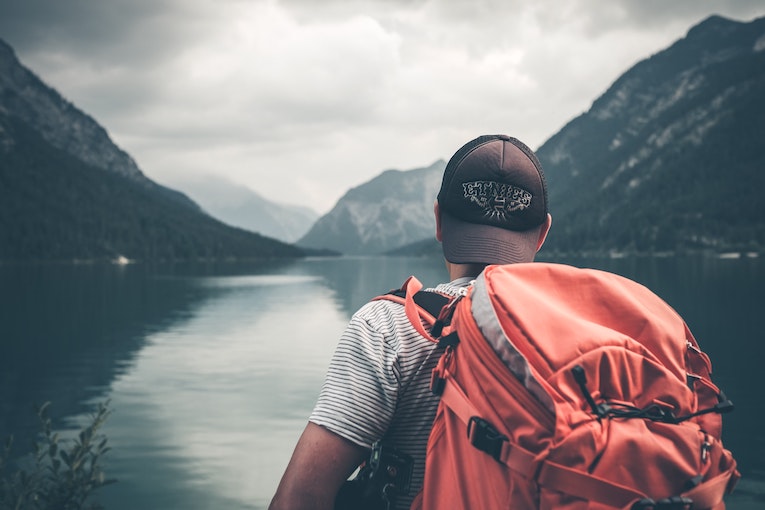
First step to adventure? Preparing for an international flight.
But international travel isn’t all fun and games. Between visas, security checks, long haul flights, and the drama of packing, international travel can be overwhelming—whether it’s your first time flying internationally or not.
It’s natural to have questions as you’re preparing for an international flight. Learn what to know before flying internationally, so you can begin your travel plans with confidence and ease.
If it is your first time flying internationally alone, you may be wondering, “ where do I even start? ” Who can help you navigate the nitty gritty of international travel? Lucky for you, every question you could imagine is right here at your fingertips.
What is the difference between domestic and international flights?
While domestic flights take you to other destinations within the same country, international flights take you overseas. If you’re planning to travel abroad, it’s important to know that you’ll be flying internationally.
Airports typically have separate domestic and international departures, with airport procedures before take off looking quite different. Keep reading to find out what to know when flying internationally.
How early do you need to be at the airport for international flights?
When preparing for an international flight, you’ll need to arrive at the airport at least three hours before your departure time. Three hours might seem like a long time, but between checking your bags, moving through various security checkpoints that may have you waiting in enormous lines, and finding your way to your gate, you’ll be happy you allowed yourself plenty of time.
Most international flights begin boarding between 40 and 60 minutes before take-off, leaving you only about two of those hours to get to your plane. Worst-case scenario? You arrive early and get to kill time in the food court or grab a quick beverage at the airport bar.

Dig into a pre-flight meal while you wait for your flight to board.
What do I need to fly internationally?
Flying internationally requires a lot more than just your passport. While your passport is absolutely essential , most countries require your passport to be valid for at least six months longer than the dates of your trip. Some places also require you to have a certain number of blank pages to allow for visas and stamps.
Depending on where you’re headed, you may also need a visa , proof of onward or return travel, or proof of immunizations. The truth is, every destination will have different travel regulations, so it’s important to check with your destination when preparing for an international flight.
FAQs about preparing for an international flight
1. how to pack for international flight.
Packing for an international flight can be overwhelming, no matter how long you plan to be away. The very first step is to check your baggage allowance with the airline. How many bags are you allowed to bring on board? How big can they be and how much can they weigh?
Once you figure out how much you can bring, separate your checked and carry on bags:
- In your checked luggage, pack classic clothing items that can be mixed and matched to save space—even better if they’re lightweight and quick-drying fabrics. Remember that less is more, especially because you’ll want to leave a little extra room for souvenirs.
- In your carry on, pack your essentials, all your travel documents, and anything you might need while in flight.
Don't forget to weigh your bags after packing to make sure you aren’t hit with outrageous luggage fees at the airport.
2. How to prepare for a long international flight
When preparing for an international flight, you can do a few things to make sure you’re ready for the long haul:
- Get lots of rest in the lead up to your trip—flying can be exhausting!
- Take your Vitamin C to boost your immune system.
- Move your body before the flight so you feel prepared to sit for longer periods of time.
- Load up on entertainment—music, movies, TV shows, and books—to keep you busy in flight.
- Set your phone to the local time zone of your destination as soon as you get on your flight so you can minimize jet lag.
Remember, the more prepared you are, the less anxious you’ll feel when it comes time to travel.
3. What to do before an international flight

If it’s your first time flying internationally, making a to-do list will help ease your mind.
Make yourself a checklist. Do you have your passport, visa, and all your travel documents easily accessible? Have you purchased travel insurance ? It’s always a good idea to have travel insurance to protect yourself during international travel, just in case.
Next, make sure you let your bank know you’ll be traveling overseas. Having your bank freeze your credit card for unexpected transactions while you’re abroad is one big (but avoidable) travel nightmare .
So, notify your bank that you’ll be traveling. While you’re at it, check the international transaction fee policy so you know what to expect, and perhaps get some cash converted so you have it on hand when you land. ATM fees are usually most expensive at the airport, so it’s always comforting to have cash on arrival.
Last but not least, check the health advisories and travel warnings for your destination so you can ensure you’re safe when preparing for an international flight.
4. What to bring to the airport when traveling internationally
If it’s your first time flying internationally alone , there’s no such thing as preparing too much. Make sure you bring all of your travel documents with you, and if you have time, make digital copies of your travel documents too. You’ll want to bring all of these to the airport with you along with your carry on and checked luggage—and your comfiest clothes to wear in flight.
FAQs about documents needed for an international flight
1. what are the documents required for international travel.
When flying internationally, having a valid passport is non-negotiable. However, every country has different travel requirements beyond that.
If your destination country requires a visa, you will need to show this at the airport when you check in for your flight. In the days of COVID-19 , you may also need to show proof of vaccination for travel.
Check out the policies of your departure, arrival, and any transiting countries so you know exactly what documents are required for each leg of your trip.
2. Can you travel internationally with just a passport?
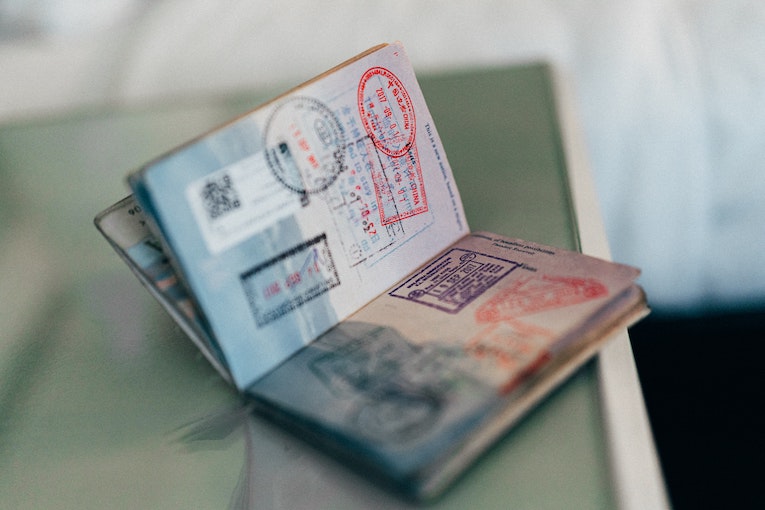
Ready to start collecting passport stamps? Yeah, we thought so.
This depends on where you’re traveling. Some countries allow departure and entry with just a passport, but many international destinations require a visa in some capacity.
Some countries allow you to get a visa on entry, with some visas free and others obtained with a fee. This is another big one to check on your destination’s immigration website before you depart so you know exactly what to expect when flying internationally.
3. Do I need my driver's license to travel internationally?
Typically, you’ll only need to show your passport when checking in for a flight, but it’s always a good idea to bring a driver’s license or another form of ID just in case.
Your driver’s license may come in handy more when you arrive at your destination, as carrying your passport around in a foreign country comes with some risks. You might want to put your passport away, lock it in your hotel safe, and use another form of identification when you’re out and about abroad.
4. Do you need two forms of ID to fly internationally?
Though you typically will not need two forms of ID to board a flight, if you have a second form of ID, bring it with you. If you are requested to show a backup ID or lose your passport while abroad, it’s always a good idea to have multiple proofs of identification on hand.
FAQs about international connections and baggage
1. what is allowed in carry on luggage on international flights.
Most airlines have a limit to how much luggage you can carry onto a plane as well as limits on the size, shape, and weight of your bags. Many airlines allow one piece of carry on luggage plus a personal item like a purse or backpack that can fit under your seat, but it’s always best to check with your airline.
You’ll always need to limit the amount of liquids you carry on to small bottles of 100 mL or less. All bottles will need to fit into one quart-size resealable bag.
Other regulated items include:
- Sharp objects
- Household items and tools
- Medical equipment
When packing your carry on, check the TSA guidelines .
2. What to pack in a carry on for an international flight

Your favorite clothes are just the top of your must-have packing list.
Use this checklist for packing your carry on to feel prepared for your international adventure:
- All travel documents (passport, visa, etc.) plus copies of each.
- Small toiletries that you’ll need for a long haul—think toothbrush, toothpaste, and deodorant at least.
- Any medications needed abroad, stored in their original containers.
- An eye mask, ear plugs, and pillow to get a good night’s sleep.
- An empty water bottle that’s easy to refill.
- Your electronics (laptop, phone, kindle, headphones) and their chargers.
- Snacks to tide you over, especially if you won’t have meals served on your flight.
- Spare undies and a change of clothes—just in case!
- A pen for your customs forms.
- Any other valuables.
3. Do I have to recheck my luggage on an international flight?
If you’re wondering what to know before flying internationally with layovers, it’s always best to check with your specific airline. Most international flights will check your luggage all the way through to your final destination, but this could change depending on your flight route.
For example, some countries require you to recheck your bag at the first point of entry, which means you’d need to pick up your bag, go through customs, and then recheck your suitcase for your next flight. When you first check your luggage at the departure terminal, ask the airline staff and they will let you know if your particular flight path requires you to recheck your luggage.
4. How much time do you need between connecting flights internationally?
If you want to be safe, allow at least two hours between connecting flights. Sometimes you can get away with shorter layovers, but it will undoubtedly be stressful.
Remember you may need to go through security if your connection is in another country, and it’s common for flights to be delayed—two hours will go by in a flash.
5. When do you go through customs on international flights?
Usually, you go through customs when you exit the airport at your final destination. However, if you have a layover in a different city in your destination country, you may need to go through customs before your connecting flight.
How to board international flight step by step

You’ve got this! Memories to last a lifetime wait on the other side of your flight.
Now that you know what to expect when flying internationally, it’s just a matter of showing up at the airport and going through the process to check in and get to your gate. Don’t be intimidated, it’s actually quite simple!
1. Check in for your flight.
Sometimes you can check in online, but if you have enough time and have questions, checking in at the airport can ease your nerves. This way, you can speak to your airline staff and ask any questions about your journey that you haven’t answered already. Make your way to the international terminal and find your airline’s check-in stand to get started.
2. Check your baggage and get your ticket.
When checking in for your flight, you’ll have an opportunity to check your luggage. The airline staff will give you your boarding pass and a tracking sticker that matches the one on your luggage. Keep these safe and tucked into your passport for easy access throughout the airport.
3. Go through the security checkpoint.
Now that you’ve lightened your load, it’s time to go through security. Follow the airport signs or ask the airline staff where to get in line for the security checkpoint. Typically, this involves waiting in line, scanning your carry on luggage, and showing your passport and boarding pass to enter the terminal.
4. Go through immigration.
If you’re flying internationally, you may need to go through a second security screening before your flight: immigration. All you’ll need to do here is show your passport and follow the instructions from the immigration staff. This is the last step before you can walk to your gate for your flight.
5. Find your gate.
You’re in! Your boarding pass will usually tell you the gate where you’ll board, but if it doesn’t, check the screens just past immigration. These screens list all destinations and their boarding gates. You may also want to double-check the information on your boarding pass—gates sometimes change.
Make your way to your gate and relax. If you arrive with time to spare, you may wish to explore your terminal a bit more, shop for snacks or books, or grab a meal and drink at one of the bars or restaurants nearby.
6. Board your flight.
About 40 to 60 minutes before your international flight, you will hear the airline staff announce boarding. Make sure you are at your gate and ready to board. Many airlines will board in groups, so check your boarding pass for your boarding group or zone, wait to be called, and line up. Have your passport and boarding pass ready to show the flight attendant, find your seat, and enjoy the ride!
Our Online Advisor can match you with 5 travel programs—it’s free!
Don’t panic—flying internationally is so much easier than it seems.

The world awaits, so where will your first international flight take you?
While there’s a lot more to flying internationally than traveling on a domestic flight, it’s actually so much easier than it seems. Give yourself plenty of time to prepare for that first time flying internationally to make sure you have everything you need, and don’t be afraid to ask questions if you’re in doubt. Once you know what to expect when flying internationally, those long flights will seem like a breeze and the world will be at your fingertips .
Find Flights & Transportation with Our Travel Resource Hub

Explore Programs on GoAbroad.com
Related Articles

By GoAbroad Writing Team | 2 days ago

By Julia Zaremba | 3 days ago

By Hannah Sorila | 3 days ago

By GoAbroad Writing Team | 4 days ago
Popular Searches
Study abroad programs in italy, study abroad programs in spain, marine biology study abroad programs, study psychology abroad, fall study abroad 2024, spring study abroad programs, recommended programs.

1682 reviews
International Volunteer HQ [IVHQ]

1932 reviews
MAXIMO NIVEL

563 reviews
Intern Abroad HQ

2731 reviews
African Impact
For Travelers
Travel resources, for partners.

© Copyright 1998 - 2024 GoAbroad.com ®
- Study Abroad
- Volunteer Abroad
- Intern Abroad
- Teach Abroad
- TEFL Courses
- Degrees Abroad
- High School Abroad
- Language Schools
- Adventure Travel
- Jobs Abroad
- Online Study Abroad
- Online Volunteer Programs
- Online Internships
- Online Language Courses
- Online Teaching Jobs
- Online Jobs
- Online TEFL Courses
- Online Degree Programs
- Travel Planning Center
- Ticket Changes & Refunds
- Airline Partners
- Check-in & Security
- Delta Sky Club®
- Airport Maps & Locations
- Flight Deals
- Flight Schedules
- Destinations
- Onboard Experience
- Delta Cruises
- Delta Vacations
- Delta Car Rentals
- Delta Stays
- Onboard Wi-Fi
- Delta Trip Protection
- How to Earn Miles
- How to Use Miles
- Buy or Transfer Miles
- Travel with Miles
- SkyMiles Partners & Offers
- SkyMiles Award Deals
- SkyMiles Credit Cards
- SkyMiles Airline Partners
- SkyMiles Program Overview
- How to Get Medallion Status
- Benefits at Each Tier
- News & Updates
- Help Center
- Travel Planning FAQs
- Certificates & eCredits
- Accessible Travel Services
- Child & Infant Travel
- Special Circumstances
- SkyMiles Help
Preparing for Your Trip
1. travel checklist, 2. packing your carry on, 3. fly delta app, 4. pre-trip email, 5. travel requirements, 6. masks are optional, 7. need a ride.
* Tips, gratuities, tolls, taxes and other incidental fees are excluded from mileage credit. Terms: Delta.com/Lyft .

Related Links
Travel Requirements
Safety Commitment
Food, Services & Amenities
- Investor Relations
- Business Travel
- Travel Agents
- Comment/Complaint
- Browser Compatibility
- Accessibility
- Booking Information
- Customer Commitment
- Tarmac Delay Plan
- Sustainability
- Contract of Carriage
- Cookies, Privacy & Security
- Human Trafficking Statement (PDF)
80 Packing Tips For International Travel
We use affiliate links, and receive a small commission if you make purchases through them. Find out more here .

Unlock the Ultimate Guide to Airline Luggage Allowances
Don’t get caught off guard by unexpected baggage fees! With this comprehensive eBook, you’ll have all the information you need at your fingertips.
You have successfully joined our subscriber list.
Packing for an international trip can be overwhelming. You want to prepare for every possible situation but at the same time, you have to make sure that you don’t overpack. No one wants to pay for those fees! Let’s take a look at the best tips and tricks to make sure that you’re sufficiently packed and prepared to enjoy your trip.
Rather watch a video? I shared the 10 most essential packing tips below for those who don’t want to read the full article.
International Travel Documents
1. Before packing your passport , make sure that the expiry date is longer than six months. Some countries won’t let you in if the expiry date is too short. For your specific destination, read their laws for traveler’s passport requirements.
2. Be sure to pack a traveling visa if needed. Some countries require a traveling visa before entry and usually have a deadline for how long you can stay. If you’re a European Union citizen, things are easier for you if you’re traveling to Europe.
3. If traveling with children, get a child travel consent. If a child under 18 is traveling with only one parent, written permission from the other parent will be needed.
Read Next: What to Put in Carry-on and What in Checked Luggage (Guide)
4. Print a copy of your travel insurance. If you don’t have one, I highly recommend that you get one, as it’s usually really cheap and protects against medical costs, theft, flight delays, and more.
5. Pack all of your travel documents in a separate bag or a folder and always carry them with you. Never put your documents in your checked bag and always keep an eye on them. Also, it’s better to take pictures of them and email a copy to yourself in case they get lost.
6. Print out a copy of your boarding pass. It will work as a backup if your phone battery dies.
7. Don’t forget other documents: Train, bus, ferry, or plane tickets, hotel reservations, tickets for attractions and museums, a piece of paper with emergency contacts, guides and maps, and local tourist cards.
Read Next: You Bought Airline Tickets Online. Now What? (Guide)
Electronics

8. Don’t forget to bring your camera, smartphone, laptop , e-reader , headphones, and a tablet (if you plan on using them.) I usually leave the camera and tablet, as my smartphone and laptop can easily substitute both.
9. Bring dual-voltage chargers for all of your devices. If you’re located in America and traveling to Europe, make sure that all of your chargers are dual-voltage. That’s because the USA uses 110v electricity, but Europe uses 220v. If you don’t have an adequate charger, you will ruin your device. Something like this will be written on your charger: “100v-240v.”
10. Never pack electronics in your checked luggage. Use your hand luggage or carry-on instead. Otherwise, they might get stolen or damaged, and airlines usually don’t reimburse for valuables, such as electronics.
11. Always charge your electronics before boarding. Sometimes the airline security will require you to turn on your devices. Some airlines don’t allow carrying devices that you aren’t able to turn on. If you’ve forgotten your chargers, this could potentially turn into a bad situation. Also, make sure to turn Airplane mode on before setting off.
12. Get a power adapter. In Europe alone, there are three different kinds of power adapters. You should research what kind of plugs that your destination country has and purchase accordingly. There are some universal ones as well which would be a good investment to make if you plan on traveling internationally often.
13. Pack your power bank. A power bank is a must-have, especially for international flights . Most of your gadgets won’t last twelve or more hours while you’re watching movies and tv-series, so make sure to charge them fully before boarding.
Toiletries and Medication

14. Pack liquids over 3.4 oz in your checked suitcase. In your carry-on, you can pack liquids that are in 3.4 oz bottles , and all of the bottles combined have to fit in a TSA-approved transparent bag (usually around ten small bottles.) If you plan on packing something larger, you will have to check it in.
15. If you’re staying at a hotel, leave your shampoo and shower gel at home. Most hotels have these included in your bathroom, free of charge.
16. You’re safe to pack your medication. TSA states that all medicine is allowed both in hand luggage and checked bags. I’d pack it in my hand luggage though, in case I might urgently need some of it. Also, if the medication is in liquid form and over 3.4 ounces, but in reasonable quantities, it’s allowed on the flight. Note that the medicine needs to be in its original packaging.
17. Some medication that you might forget: Something for allergies, motion sickness tablets, asthma medicine, painkillers, cream for sunburns, bandages, digital thermometer, diarrhea medicine, cough drops, insect repellant, antacids, sleep aids, and eye drops.
18. Some toiletries that you might forget: Toothbrush, mouthwash, dental floss, toothpaste , deodorant, shampoo, and shower gel (if traveling to a hotel, leave them home), sunscreen, face wash, q-tips, make-up, contacts, make-up remover wipes, shaving cream, shavers , hair-gel or hairspray, perfume , and dry shampoo.
Read Next: Will Shaving Cream & Other Aerosols Explode on a Plane?
19. If you need prescription medicine, don’t forget to bring the prescription with you. Some countries accept prescriptions from other countries, So bring it along just in case you run out.
20. Pack your medicine in a separate, ready-to-go pouch. You never know when you’re going to need it, so it’s better to be able to find anything quickly, rather than re-sorting your entire suitcase.
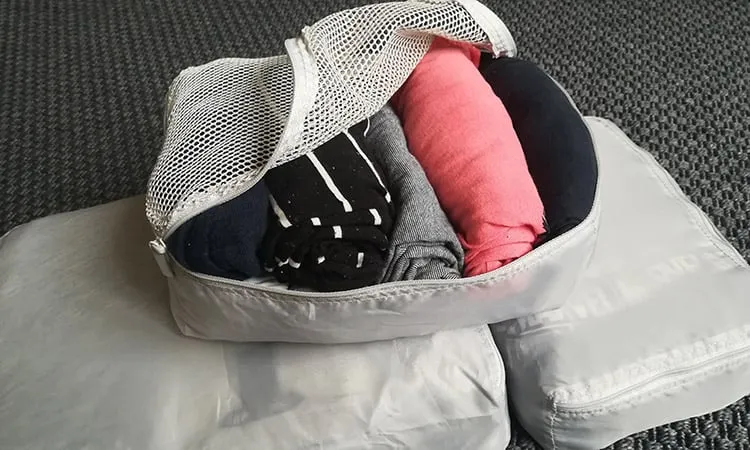
21. Between two similar options, always choose the lightest. For instance, I never take my big, comfy, black hoodie. Instead, I take a thinner one, which is just as warm but takes up less space. The same goes for boots vs shoes.
22. For longer trips, bring less and wash everything mid-way. Usually, larger hotels have the option to do the laundry for you, which is perfect for two to four-week trips. Even if they don’t, ask around, and they’ll usually tell you where is the nearest place to do laundry. Alternatively, underwear and socks can be easily washed in the sink with regular soap. Just make sure to do this with enough time to hang them to dry!
23. Dress in layers. If you’re traveling to colder climates, an excellent way to save space is to dress in layers. Rather than taking large jackets and hoodies, take several thin shirts.
24. Wear the bulkiest clothes and shoes on your flight. By doing this, you will save some space in your suitcase. You can take something off once you board the flight. (I like to take my shoes off when I fly. (Sorry, if you ever sit next to me!)
25. Choose a color scheme. Basically, you should be able to combine any two pieces of clothing to make an outfit. Avoid packing outfits for every day that don’t go together separately. This way, you can wear your jeans for several days while changing your t-shirts and underwear every day.
26. For your flight days, you can pack a single outfit. For instance, if you’ve gone for seven days, pack for six days, because you’ll be wearing the same thing on your first and last day. Do you care that much how you’re looking on the plane? I always go with comfort over fashion.
27. Research the fashion culture in your destination. For instance, if you’re a woman, you don’t want to wear something that reveals lots of skin in Arabic countries. In Europe, people tend to dress a bit more formally than in America. So, pack accordingly.
28. Underwear and socks. I recommend packing a pair for every day. For longer trips, bring only half and wash everything mid-way through your trip.
29. Jeans, pants, and shorts. Personally, for a two-week trip, I would bring a pair of jeans and two pairs of shorts. I pick one that’s more casual and another that’s for outdoor activities like hiking, horseback writing, etc.
30. T-shirts. If you roll them, they don’t take up that much space, so I take one for every day. (Although, you could take one for every two days.)
31. Hoodies, shirts, jackets. If I’m traveling to warmer climates, I usually skip the bulkier jackets. A single hoodie and a thin shirt are enough. For colder places, I’d pack one for every three days. Don’t bring more than one jacket, as they take up a lot of space.
32. Dresses. I feel that dresses are perfect for traveling, as they take up so little space. Just don’t go overboard and remember to pack a pair of jeans as well for activities and hikes.
33. Suits and formal clothing. If traveling for business, suits and formal clothing are a must. Don’t forget to bring a pair of high heels or formal shoes, ties, a suit or a dress, and other accessories.
34. Sporting gear. I like to continue my exercise routines while traveling so I bring a pair of running sneakers, shorts, and a t-shirt. If you’re active, don’t forget to pack your sports gear if you want to go to the gym or go for a run.
35. Shoes and boots. I usually bring no more than three pairs of shoes : A pair of running sneakers, casual shoes, and flip-flops or boots (depending on the weather.) Shoes take a lot of space, so think twice about bringing extra pairs.
36. Accessories that you could forget packing: Hats, scarves, swimsuits, towels, gloves, belts, pajamas, and jewelry. All are totally dependant on where you go, so it’s up to you to decide if you need them.
Additional tip #1: Ever had bed bugs in your luggage while staying in a cheap hotel? Check out our guide on getting bed bugs out of luggage , and how to prevent them in the future.
Miscellaneous Items That You Could Forget to Pack

37. Take food and snacks. If you’re flying a short flight with no lunches, you should get some snacks to save some money. You’re allowed to pack almost any food, as long as you follow the 3.4 oz rule. The rule states that you cannot pack liquids in bottles larger than 3.4 oz in your hand luggage. This includes sauces, creams, and other liquids. However, checked luggage is totally fine. Also, you should be careful with packing organic food and dairies, as some countries won’t allow you to enter with specific foods.
Read Next: Can You Bring Chef’s Gas Torches on a Plane?
38. Always take an empty bag for your dirty clothes. If you start mixing your dirty clothes with your clean ones, pretty soon your clean clothes will start smelling. I’d recommend packing a special laundry bag or a plastic bag. Tote bags aren’t that good because they let air through the fabric because plastic doesn’t.
39. Pack a few zip-locks, plastics bags, and a tote bag. They don’t take up much space, and you never know when you are going to need them. I usually take a piece of bubble wrap as well if I’ll be bringing home some bottles of wine.
40. If you have a luggage scale, take it. If you don’t, get one . It’s handy for your return flights, especially if you’re visiting several countries. With it, you will be easily able to weigh your suitcase and tell if you can buy any more snacks and souvenirs for your return flight. It costs just a few dollars and takes up very little space.
41. Other items that you could forget: umbrella , sunglasses, regular glasses and a case, tweezers or a pocket knife, hand sanitizer, paper/pen, a fork, and a spoon, a cup, and a plate, cash, keys.
Preparing for a Long International Flight
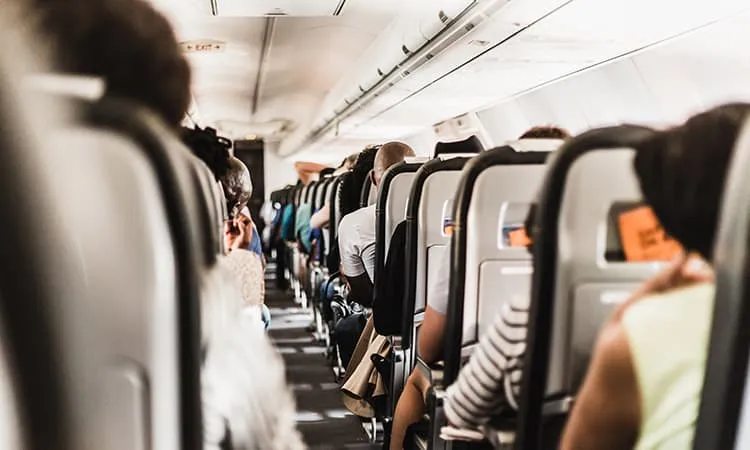
42. Download e-books, movies, and tv series before your trip. The flight will be long, usually twelve hours or more. To keep yourself entertained, make sure to download everything in advance. Time will go by faster! (I tend to write/sleep the entire flight.)
43. Pack everything for a comfortable trip. Do you think that sitting in a seat for ten hours will be comfortable? Well, think again, because you’re likely to feel stiff and exhausted after your flight. If you have the room, pack a pair of trainers, a hoodie, soft socks, a sleeping pillow, and a face mask for comfortable sleeping.
44. Pack things that will help you with having more privacy on your flight. You never know who you will be sitting next to. You could be sitting next to someone who wants to talk throughout the flight or is watching movies on a bright screen. Prepare in advance by packing noise-canceling headphones or earplugs and a face mask.
45. To freshen up, pack some wet wipes and hand cream in your carry-on. Although this is optional, cleaning your hands and face with wet wipes will make you feel much fresher. The dry air and pressure changes can make you feel like you haven’t showered for several days.
46. Wear glasses instead of contacts. I’m not sure why, but flying with contacts for longer than one or two hours is nearly impossible. It probably has something to do with the pressure changes and dryness. So pack your contacts in your baggage and wear your glasses instead.
Before You Start Packing Your Suitcase
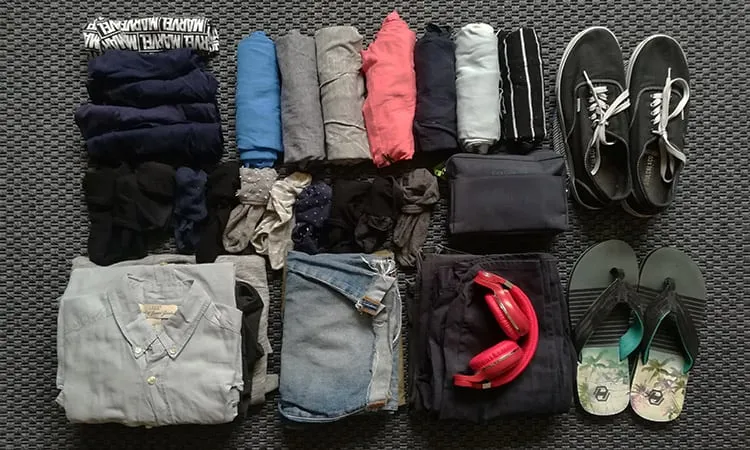
47. Before you start packing, make a list of all your items. This will help you to avoid forgetting something. Some apps help you with creating a packing list. Check out this handy printout PDF!
48. Lay all of your items on the floor or the bed. Reading a list can be one thing, but looking at all of your items in front of you will help you to see how tightly you should be packing. Re-check if you have everything that’s on the list.
49. Determine the weight and size restrictions for your flight. For international flights, you will usually find that the carry-on limits are tighter, so be sure to read up on the airlines’ website and measure your luggage . Here are the most common airline restrictions .
50. Choose the appropriate luggage . If I fly with a checked suitcase, I usually take a backpack and a large suitcase. Make sure that everything is within the size limits. Also, I would recommend taking luggage with spinner wheels if you have to walk long distances.
Editor’s tip : If you’re looking for a new carry-on, we’ve found that the Travelpro Maxlite 5 is the best choice. We’ve compared the most popular luggage brands , and we’re most impressed by Travelpro. It got 90 out of 100 points on our rating scale.
51. If you have an old suitcase, give it a good clean. I recently tried restoring my old suitcase and was pretty successful with it. With proper techniques, you can make your old bag look brand new .
Tips on Packing Your Suitcase
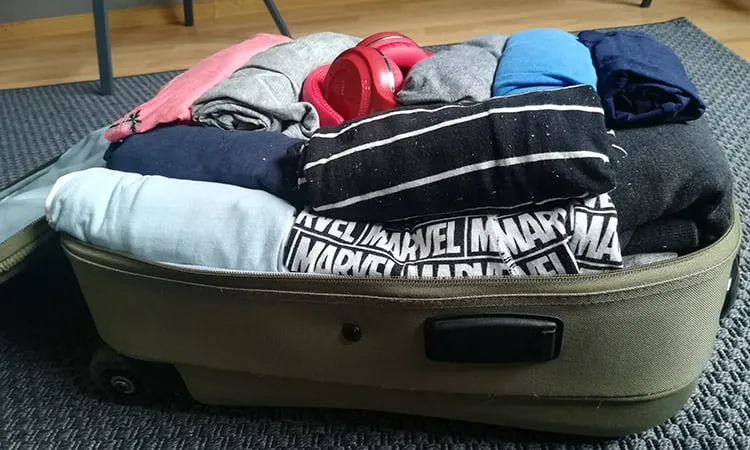
52. Pack these items in your carry-on: Documents, electronics, clothes for one or two days (in case your checked luggage gets lost), chargers, toiletries, and medicine.
53. Pack these items in your checked suitcase: Extra pairs of shoes, all of your other clothing, liquids over 3.4 oz, knives, and other things that are not allowed on the flight.
54. Start by packing your documents. Put all of your documents and printouts in a folder and stash them in an easily accessible place. A good choice would be your carry-on, backpack, or duffel bag, depending on your choice of hand luggage.
55. Utilize packing cubes. They’re a great way to organize your items and save a little bit of space. I usually divide the cubes by their contents. For instance, one is for electronics, another is for chargers and smaller items, and one is for bulkier clothing, etc.
56. Before you start packing, roll, and fold your clothes. For easier packing, I always roll my t-shirts, pants, jeans, shorts, and underwear. This saves a lot of space and usually, the items don’t get that wrinkled (if you do it correctly.) Other than rolling, I fold my shirts and other things that need to be wrinkle-free. If you’re using packing cubes, fold them in the exact size of the largest cube, which will help when you’re packing it.
57. Fill your shoes with socks and underwear. Not only does this save space, but your shoes won’t get squashed after unpacking.
58. If you’re using packing cubes, pack them full. This results in fewer wrinkles on your clothes. Also, pack in a way that your items are easy to pull out. (Rolled pieces help a lot!)
59. If packing without cubes, start packing with shoes and larger items. Ideally, you want to place your shoes and heavier items down at the bottom of the case, because this will result in a better-balanced suitcase. (It’s less likely to tip over!)
60. Fill the gaps with smaller items. When you’ve finished with the larger things like shoes, jackets, jeans, hoodies, and the toiletry bag, fill the gaps with socks, underwear, and t-shirts.
61. If using a carry-on and suitcase, never pack valuables in your checked suitcase. Items packed in your checked luggage could get lost or stolen, and most of the time, airlines don’t cover electronics, valuables, fragile items, and jewelry. If you have no other choice, purchase separate travel insurance for the contents of your checked bag.
62. Pack fragile items and liquids carefully. Here’s a full guide on packing fragile items in luggage .
63. If you’re bringing a knife, follow the TSA rules. You can’t put knives in your carry-on . Instead, you should pack it in your suitcase.
64. Leave some room for the return items. Are your friends, colleagues, and family are already wondering what snacks or souvenirs they will be getting from you when you get back from your trip? Make sure that you leave some space for your return items and souvenirs. I’d say that an extra two to five pounds is enough.
65. Make sure to use the straps in your suitcase to tighten your contents. I’m amazed at how many people aren’t doing this, especially if they’re not using packing cubes. If you tighten them, your clothes won’t be all over the suitcase, and you will have fewer wrinkles because there will be less movement.
66. Weigh your bag and make sure that it’s close to the weight limit. Most of the time, the airline staff will let you pass with a few extra pounds. However, sometimes they will not, so to be safe, you should always follow the weight limit.
After You’ve Packed Your Suitcase
67. Make your suitcase easily visible. Adding some stickers, luggage straps, or other colorful elements will do two things to help you while traveling. First, your suitcase will be easily identifiable on the conveyor belt. Second, if your luggage gets lost , you can better describe your suitcase to the airline staff, which will increase the chances of them finding it. If you bring two or more suitcases, it’s also a good idea to hook them together .
68. Re-check if your documents and valuables are packed in your carry-on. Checked suitcases can easily be stolen or lost. You don’t want to lose your documents while abroad.
69. Consider purchasing insurance for your checked suitcase. Airlines reimburse only small amounts for lost suitcases, as they value everything as used. (Even if it’s brand new.)
70. If you’re above the weight limit, start by removing clothes. 80% of your suitcase is easily taken up by clothes. Most of the time, you’re taking too much. Consider packing for a week and washing your clothes after seven days. Do you really need to bring those boots to Finland in the summer? Do you need that extra jacket just in case it gets cold in Italy? No, you don’t.
71. Add luggage tags to your suitcase. Using luggage tags dramatically increases the chances of your suitcase being found in case it gets lost. Write your e-mail address, the initial of your first name, and last name. (You don’t want everyone to see all of your information.)
72. When locking anything, use only TSA-approved locks . Some beginners might not know this, but everything that you lock in your luggage has to be locked with TSA-approved locks. Whether you’re locking the suitcase itself or a box of valuables inside, the TSA locks will allow the TSA agents easy access inside. Otherwise, they’re authorized to break the lock, and you could end up with a broken suitcase.
73. If you’re worried about your checked suitcase being damaged, use a luggage cover . This protective cover helps with keeping your suitcase look brand-new. In some third-world countries, luggage handlers can be really tough on your suitcase, so protecting it could be a smart move. A cheaper DIY temporary solution would be to cover it with a plastic film.
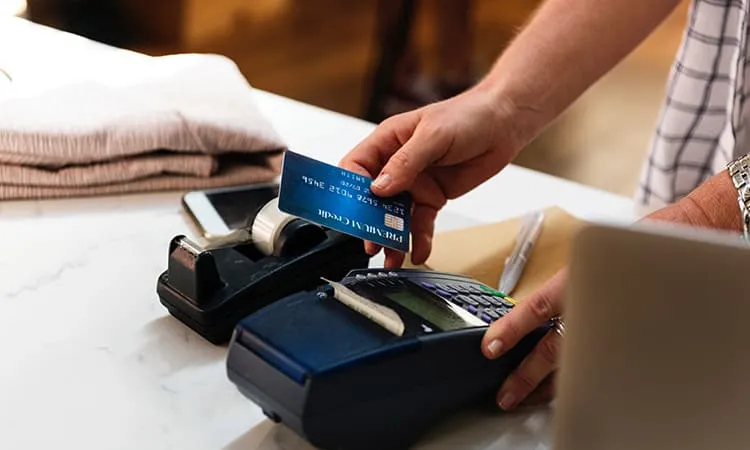
Money and credit cards
74. Don’t exchange money in money exchanges. You’ll probably need to pack some cash with you. Most of the time, the rate is the best when withdrawing through a well-known ATM at your destination. Airports and money exchanges will always have slightly worse rates. When you arrive, look for a well-known ATM (private ATMs often have higher fees) and withdraw from your ATM card.
75. Use your credit cards wisely to avoid extra fees. It’s not a packing tip, but I’ll include it anyway, as it’s essential. For withdrawing money, don’t use your credit card. Instead, you should use an ATM card. Only use your credit card for paying in another currency with your card, as the exchange rate fee is always smaller for credit cards. Also, when paying with your credit card, you will often be asked if you want to be charged in the local currency or US dollars. Always choose the local currency, as the rate will be better. So to sum up: Pay with your credit card in the local currency, and withdraw with your ATM card from well-known ATMs.
76. Notify your bank and credit cards that you will be traveling. Your bank or credit cards can freeze your accounts if they notice strange transactions and that’s the last thing you need while you’re on a trip. Notifying them ahead of time will help you to avoid this issue because they will add a record to your account for the fraud detection system.
77. Educate yourself on local currency. It can be incredibly difficult to tell the difference between different coins and bills if you’re not from that country. Learning about the currency where you’re headed can save you a lot of headaches and from possibly being swindled, too!
78. Consider getting a wallet or purse that you use specifically for travel. There are a lot of options out there for the safer storage of your personal items. You might want an RFID wallet like this one on Amazon that insulates you from electronic pickpocketing. You can also invest in a waterproof, crossbody bag that will keep your items safe from the elements as well as make it harder for thieves to try to grab from you.
79. Consider using prepaid travel cards. If you don’t want to bring along your debit or credit cards, consider using a prepaid travel card instead. You can load a specific amount of money onto the card before your trip, allowing you to lock in your exchange rate.
80. Hide your money. Hide your money on your body by using a scarf with a hidden compartment, a leg money belt, a security belt with a hidden wallet, etc. If you’re planning on leaving money in your hotel room, you can easily hide your cash if you make a plan. You can tape it underneath drawers, stash it in food packets inside of your mini-fridge, or even inside of the couch cushions.
Final Words
Packing for your trip will be easier and less stressful if you prepare in advance. Using tips like those listed above will ensure that you’re ready. The most important thing to take away from reading this is how crucial it is to make sure your travel documents are safe. Keeping them in a folder in a place that you will remember and is easily accessible is of the utmost importance.
Something else that’s important to remember is that you need to pack only as many clothes as you will realistically need. Going over the weight limits will end in hefty fines. You might also want some space for souvenirs! Wearing layers onto your flight can also give you more space in your suitcase but make sure you will be comfortable as international flights are long and exhausting.
The best thing you can do is use an app or create an itinerary to keep track of your items. You don’t want to forget items like chargers, power blocks, medications, or other items necessary for your trip. Keep yourself organized and you will have a worry-free experience!
Read Next: 30 Things to Do Before Traveling Abroad
You Might Also Enjoy
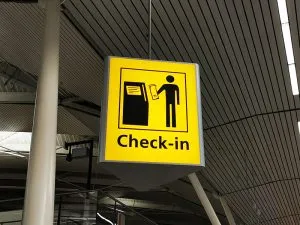
One response to “80 Packing Tips For International Travel”
Oscar, your reflections on inner growth resonated with me. I too find solace in nature, especially during morning walks when the dew is still fresh. How do you cope when you can’t connect with nature? Isn’t it interesting how our surroundings influence us, and often mirror our internal state? I find urban environments, with their chaotic beauty, offer a completely different yet enriching perspective on personal development. Perhaps, we could explore this in a future discussion. My own experience in New York City was a turning point for me, the hustle and bustle pushed me out of my comfort zone and into a space of self-discovery. Keep the discussion flowing, Oscar, your insights are a breath of fresh air. 🌿🌆
Leave a Reply Cancel reply
Your email address will not be published. Required fields are marked *
Save my name, email, and website in this browser for the next time I comment.
Featured in

GET CONNECTED
Follow Clever Journey on social media for travel tips, packing hacks, and latest updates!
SUB TO NEWSLETTER
Subscribe to our newsletter to get the latest travel tips, packing hacks, gear reviews, and bargain deals straight to your inbox. We hate spam, so we’ll send only the most important stuff.

What to Pack for International Travel
A s a travel advisor , I get so much joy out of helping people plan aspects of their trips and sharing tips about my favorite destinations. One question I get the most is about what to pack. This is why I create so many seasonal Packing Lists for popular European destinations in particular.
Things To Pack For International Travel
Packing for international travel is an art form and sometimes can be one of the most daunting tasks when it comes to traveling abroad. Packing the right things helps to ensure your trip overseas is fun, safe, and stress-free. This post will help you with handy packing tips and I share a lot of my travel essentials I always have with me when I head out of the country. There is even an international travel checklist you can save down for future trips!
I generally stick to a few self-imposed rules when it comes to packing for my overseas trips and after many years of travel, my formula is down rather pat at this point. If you have interational travel on the horizon, my packing tips should be helpful to both inspire and help you plan.
What To Pack For International Travel
Mix and match outfits.
When deciding what to wear for international travel, one of the keys to packing is to choose items that you can mix and match. I recommend you bring several pairs of pants or shorts (depending on the season) that can be dressed up or dressed down, dresses or skirts for evening, a trench coat, a leather jacket or some other mid-layer depending on the time of year, a neutral blazer or tweed jacket, one pair of shoes for evening and 2-3 pairs of comfortable shoes for daytime.
Makeup and skincare
I like to buy minis of my morning and evening skincare routine products to bring with me. For a toiletry bag, I store them all in Truffle cases (seen in All My Travel Essentials ). Many European countries are incredibly strict with their liquid restrictions (more so than TSA) so keep this in mind if you’re carrying-on for your return flight.
For makeup for longer trips, I rely on the Cuyana makeup cases .
If you’re spending time in a city, you’ll likely encounter noisy evenings so I always travel in Europe with a pair of earplugs .
Travel Documents
But of course! Remember you’ll need to bring this with you to fly but also to do any luxury shopping (for VAT refunds if the country you’re visiting allows) and to check into your hotel.
Vaccination Card
Many foreign countries have lifted their restrictions so you likely won’t need this moving forward, but I keep mine in my passport cover just in case.
Carding isn’t really a thing in many international destinations, but since you won’t want to be out and about with your passport it is good to have your license with you – especially should you need to go to the doctor or hospital.
Travel Insurance
If you’ve purchased travel insurance, be sure you have documentation of your policy.
Credit Cards
Bring along the credit cards or credit cards you plan to use that don’t have foreign transaction fees. And if you want to get cash out, be sure to have a debit card with you as well. Don’t forget to upgrade your card to a tap-to-pay if you can!
I like to keep photos of all my important documents on my phone in a folder so I can easily access them.
Electronics & Accessories
Remember that many countries are on a different electric system than the US, and even within Europe there are varying systems. The UK and Ireland have a three-pronged outlet, while the rest of Europe has a two-pronged outlet. You’ll need to bring converters , and things like your Dyson Airwrap or steamer or blow dryer won’t work even with a converter. Leave them behind and instead bring dual voltage electronics.
This is the dual voltage curling iron I use when in Europe in particular. This is a great dual voltage travel steamer .
Having a portable charger is a must! This one is my preferred model as it is slim enough to fit in purses without taking up much space. This is a great USB plug to have on hand for your hotel room or Airbnb in the UK, and this one for the rest of Europe.
Good luggage is a must. I swear by Away luggage . I have the Bigger Carry On, the Medium and the Large which is my preferred suitcase for when I spent time in Paris. They fit so much! The link included should score you $20 off of your first purchase if interested!
And don’t forget to add luggage tags to them, too!
Travel Backpack
I’m not a backpack girl myself, but I know some people love travel packs for traveling! I’ve heard great things about Calpak’s travel backpacks.
Crossbody Bag
I know things like money belts used to be considered a “must-have” item for foreign travel, but nowadays I find a crossbody does the trick. It keeps my personal items close to me and still looks cute. I love the Senreve Aria belt bag that you can wear a few different ways, and if you want to make it more nighttime just add a chain strap !
International Travel Packing List
You can save this PDF down to your phone or pin it for later! Consider it your ultimate packing list.
Depending on where you are traveling, you may also want to consider traveling with a print out of your emergency contacts, a first aid kit, a reusable water bottle, hand sanitizer (always a good idea) and printed out copies of your passport and visas that may be required for your travels.
International Travel Packing Tips
Consider the weather.
Of course the biggest consideration when packing is the weather. Be sure to check the weather forecast as you are packing! Usually a few weeks out from my trip I begin looking at the weather to see how things have been – has it rained a lot? Has it been colder in the evenings?
Prepare for rain
Regardless of the time of year, I always prepare for rain – that way, I’m not disappointed! Don’t forget to have a good travel umbrella in your suitcase and pack a chic trench coat .
Consider getting around
Be sure you check to see if where you’re staying has an elevator. Many places in Europe don’t, so you’ll want to plan (and pack light) should you need to be carting checked bags or carry on bags up narrow stairwells. Also keep in mind the type of public transportation you’ll be using and how accessible it will be with a luggage – this may also affect how you pack.
Stick to a color palette
I always stick to a color palette when I pack for Europe. I want my looks to be stylish, yet comfortable and extremely ready for mix and match wear. I’ll pack a blazer that can go with jeans as easily as it can go over a dress or pair with dress shorts or dress pants.
I’m a neutrals person when it comes to my wardrobe so usually my looks fall in a variety of color palettes such as the neutral colors of Black/Ivory/Camel or Black/Cream/Navy.
Don’t forget the power of accessories
A purposeful accessory can change an entire outfit – a silk scarf can be donned on your bag or around your neck to switch up the look of the sweater you’ve backed. Or a broach could add a bit of glam for evening on the blazer you also wore during the day time.
Be thoughtful when planning what shoes to wear
We’ve all heard horror stories of people being unprepared for the miles and miles of walking that come with visiting Europe, so be sure you’re not bringing new shoes that need breaking in. Prioritize comfort but also give consideration to what shoes won’t have you looking like a tourist. Say it with me: comfortable walking shoes are a must. You will be doing lots of walking – trust me.
Make a packing list
As you prepare for your trip, begin a packing list for Europe in your Notes app to outline the pieces you’d like to bring. Then reference that list when it comes time to pack so you won’t over pack.
Write down your outfits
I always write down my outfits for both daytime and evening when I go to Paris. This ensures I actually wear what is in my suitcase and don’t forget what’s in there. This also helps me not overpack. I have friends who also try on and take photos of the outfits they’re packing to have handy on their phone which I think is a great travel packing tip.
You can also organize packing cubes by outfit to keep things organized. Pro tip: if you’re an iPhone user, use the “touch-to-copy” feature and copy the outline of your outfit photos and paste them into the Notes app.
Leave some space in your luggage
If you have a checked bag with you, be sure to leave some room in it so you can enjoy shopping and picking up special souvenirs. You may want to consider packing cubes as well to maximize your space.
Related: My Travel Essentials
I hope you found this post helpful! Do you have any great international travel tips you can share in the Comments?
Traveling to France or the UK soon? Book with me and get customized recommendations based on your travel preferences to make your next trip to he best one yet.
You May Also Like:
- What to Pack for a Flight to Paris .
- What Shoes to Pack for Europe .
- All My Travel Essentials .
This post contains affiliate links. Should you purchase something from an affiliate link, I may earn commission, at no cost to you. Thank you for your support of my work!
![As a travel advisor, I get so much joy out of helping people plan aspects of their trips and sharing tips about my favorite destinations. One question I get the most is about what to pack. This is why I create so many seasonal Packing Lists for popular European destinations in particular. Things To Pack For International Travel Packing for international travel is an art form and sometimes can be one of the most daunting tasks when it comes to traveling abroad. Packing the right things helps to ensure your trip overseas is fun, safe, and stress-free. This post will […] As a travel advisor, I get so much joy out of helping people plan aspects of their trips and sharing tips about my favorite destinations. One question I get the most is about what to pack. This is why I create so many seasonal Packing Lists for popular European destinations in particular. Things To Pack For International Travel Packing for international travel is an art form and sometimes can be one of the most daunting tasks when it comes to traveling abroad. Packing the right things helps to ensure your trip overseas is fun, safe, and stress-free. This post will […]](https://img-s-msn-com.akamaized.net/tenant/amp/entityid/AA1i6NLe.img?w=768&h=1024&m=6)
Protect Your Trip »
27 things you should always pack in your carry-on bag.
Create your packing list of essentials and new in-flight finds.
What to Pack in a Carry-on Bag

Packing your carry-on bag for a flight is exciting – but it can also be overwhelming. With a little planning and a concise list of airport and in-flight essentials, you can maximize space and be prepared for your journey.
To help you decide what to pack in your carry-on bag, our team compiled this list of must-have items. Download the packing list here to use while you prep for your next trip, then read on to learn more about what to pack.
Carry-on packing list
Travel wallet, passport holder, toiletry bag, tsa-approved liquids bag and compliant containers, prescription medications, glasses case, travel pillow, packing cubes, tech organizer, luggage tracker, zippered pouches and reusable silicone bags, mini clip bag, hand sanitizer, bluetooth wireless adapter, wired earbuds or headphones, e-reader or a great book, travel adapter/converter, travel first-aid kit, reusable water bottle, activities or games, light jacket, change of clothing.
Protect your credit cards and cash with an RFID wallet like the Travelon RFID Blocking Single Zip Wallet , which prevents scammers from wirelessly stealing your personal information. This travel wallet is especially useful since it can also hold most smartphones.
If you're traveling internationally, an option like the TIGARI Passport Holder can protect your travel document and make it easy to locate in your carry-on bag. You'll need access to your passport at airport security, when you board the plane and when you're filling out entry forms, so keep the passport holder as well as a pen within reach. Once you arrive at your destination, put the passport wallet somewhere safe at your lodging or – if you feel inclined to keep it with you – stow it in your travel purse, belt bag or backpack to ensure it's safe while you explore.

Getty Images
Pack your toiletry bag in your carry-on so you can easily freshen up and so that you'll have essentials like toothpaste and deodorant in the event your checked luggage is lost in transit. Also consider packing toiletries that are useful for travel (particularly the dry air on planes), even if they're not part of your daily routine at home.
U.S. News senior travel editor Marisa Méndez recommends including a facial moisturizer and a body lotion in your toiletry bag. "My skin always dries out on flights and it's nice to have something to soothe my skin," she says.
"I always love having facial spray to freshen up after the flight," says Elizabeth Von Tersch , also a senior travel editor at U.S. News. She always keeps one in her purse. " Mario Badescu and Evian are great." These facial sprays help to moisturize your skin after the drying environment on a plane or give you a little midday pick-me-up.
When packing your carry-on bag for a flight, you'll want to have a clear quart-sized bag that meets Transportation Security Administration guidelines for liquids and gels. Some Dopp kits or toiletry bags include a removable bag for travel-size liquids, or you can buy this reusable TSA-approved clear bag on Amazon . Put any liquids or gels you're traveling with in this bag, including shampoo, lotion, liquid makeup items and hand sanitizer.
Keep in mind that all liquids and gels must be in travel-size bottles or containers measuring 3.4 ounces or less. Remember: You'll need to remove this clear quart-sized bag from your carry-on bag at security, so consider packing it in an external pocket or an easy-to-find spot in your carry-on suitcase. To learn more about TSA regulations, consult our article about what is allowed in a carry-on .
Never stow prescription medications in checked baggage : If luggage is lost or delayed, replacing these medications while traveling can be extremely challenging or even impossible. If you take multiple medications, consider a travel pill sorter like the EZY Dose Pill Organizer , available for about $5 on Amazon.
Whether you wear glasses for vision correction or you're packing your favorite pair of sunglasses, keeping them protected while stowed in your carry-on is essential. If you're bringing multiple pairs, a case like the foldable Dagne Dover Remi Glasses Case can hold up to three pairs, or the Lug Eyeglass Holder & Mini Pill Case works well for eyeglasses and contacts.

Courtesy of Cabeau
Resting throughout your journey can help you feel refreshed when you reach your destination and make the time pass a little quicker. But nothing can (literally) cramp your style like a stiff neck from sleeping wrong. Choose a comfortable neck pillow for travel like the top-rated Cabeau Evolution S3 or the MLVOC Travel Pillow (less than $30 on Amazon). For a travel pillow that doubles as a packing cube, consider the Tube pillow , which holds up to three days' worth of clothing.
Packing cubes aren't just for organizing clothing and shoes. Maximize space in your carry-on bag with these handy travel compartments . While Eagle Creek's PACK-IT line features the top-rated compression packing cubes on the market, many travelers also swear by the Veken Packing Cubes , which are usually available for $20 or less on Amazon. To maximize space even more, consider Lug's compression packing cubes .
If you're planning to travel with jewelry, watches or items that would be difficult to replace, be sure to put these in your carry-on bag, as checked items run the risk of being misplaced. For jewelry, a compact case that is easy to spot like the Lug Mini Swizzle is ideal for rings, cufflinks or earrings.
It's easy to let your charging cords get lost at the bottom of your bag or get your headphones tangled somewhere in your tote. A handy tech organizer such as the CALPAK Tech Organizer or the BAGSMART Tech Organizer , with zippered compartments and sections for specific cords, can help reduce tangled messes (and the need for you to search for your essentials in a tight airplane cabin).
Even though you'll have your carry-on bag with you, it's still a good idea to have a luggage tracker like an Apple AirTag or a Tile Pro securely attached to your bag. In the event you and your bag get separated, you'll be able to track down where you parted ways (because when you're jet-lagged it's easy to be a bit absent-minded).
Smaller than packing cubes, zippered pouches and silicone bags like the Stasher Silicone Reusable Storage Bags are perfect for storing everything from snacks to scrunchies. If traveling with family, consider different colored pouches for each traveler's items so you can easily tell them apart without removing everything from the bag.
Get a handy little bag with a carabiner clip, such as the CALPAK Luka Key Pouch , to securely attach to the outside of your bag for quick-grab items like gum, hand sanitizer or individual travel wipes . Once you're at your destination, you can clip it on a belt loop or use the elastic band to slide it on your wrist for your room key, lip gloss and other small essentials.
Tips on Trips and Expert Picks Newsletter
Travel tips, vacation ideas and more to make your next vacation stellar.
Sign up to receive the latest updates from U.S News & World Report and our trusted partners and sponsors. By clicking submit, you are agreeing to our Terms and Conditions & Privacy Policy .

Let's face it – traveling can introduce your body to a host of unwanted germs. Carrying a bottle of travel hand sanitizer will keep your hands clean on the go, even if there's not a bathroom nearby. To disinfect surfaces like airplane tray tables, arm rests or tables, consider having a pack of disinfecting wipes at your disposal as well.
During a flight, the low humidity and high altitude can have a drying effect on your skin and lips. To combat the dry air, consider packing a hydrating lip balm like this new stick option by Aquaphor . What's more, if you choose a balm over a liquid moisturizer, you won't need to store this product in your clear TSA-approved liquids bag.
In-flight entertainment can help your travel day go faster, but being tethered to the seatback with wired headphones can feel a bit constricting. Plus, you may have to unplug to let your seat mates in or out. Avoid those troubles and connect your wireless headphones to the in-flight system with Twelve South's AirFly ($35 or less on Amazon), which wirelessly transmits audio via Bluetooth.
If you'd prefer to connect directly to the in-flight entertainment to watch a movie (or maybe just tune out your seatmates), buy some inexpensive wired earbuds like this well-rated set by Jogteg . You can keep them in your carry-on so you're always ready, even on flights where they don't pass out complimentary headsets.
Having a book or magazine in your carry-on bag is always a good idea. Whether you encounter a delayed flight, a long layover or a plane with less than stellar in-flight entertainment, a good book will help pass the time.
On everything from red-eye flights to international jaunts, a good eye mask can block out light from overhead, the seatback screens and plane windows. The Nodpod Sleep Mask is especially relaxing since it's weighted.
"Even if you plan to grab a bite at the airport or on the plane (if that's an option), pack some snacks," says Amanda Norcross , content and SEO strategist for travel at U.S. News. "Flying is unpredictable and stressful for many travelers, and 'hanger' only makes things worse." Trail mix, granola bars, crackers, pretzels, dried fruit and popcorn are some good snack options you may want to throw in your carry-on. Also put chewing gum in your carry-on to freshen breath and help with ear popping.
It's not always easy to find a charging station at the airport, and there are restrictions when it comes to packing batteries in your carry-on baggage for any flight. One option that meets Federal Aviation Administration guidelines is the Anker 537 Power Bank (PowerCore 26K for Laptop) . This device can charge a laptop, smartphone or tablet quickly, to keep your devices running even on a long flight.

For international travel – since different countries use different plug shapes – packing a universal adapter or converter will enable you to charge your devices and other electronics. Before purchasing, consider what your needs will be, especially regarding the shape of the wall outlet plugs and the voltage of the countries you'll be visiting.
A travel adapter such as the EPICKA Universal Travel Adapter on Amazon makes plugs from the U.S. fit into electrical outlets around the world, whereas a travel converter like the ALLWEI International Travel Adapter converts the electricity voltage. If you're traveling overseas from the U.S., you'll need both of these devices to use electronics like laptops, curling irons and hair straighteners (unless your device is dual voltage, like the BaBylissPRO Nano Mini Straightening Iron ).
For minor injuries like blisters from new shoes or unexpected cuts and scrapes, pack a first-aid kit with Band-Aids and triple antibiotic ointment like Neosporin in your bag.

Staying hydrated while traveling is a must. Pack a reusable water bottle like the Corkcicle Canteen Triple Insulated Stainless Steel Water Bottle to fill up at the airport before your flight and refill throughout your travels. Even better – an insulated bottle will stay cold for hours.
Whether it's a long flight or layover (or maybe you just need a good distraction), having some activities like a miniature coloring book and mini colored pencils or small packable games can be really useful.
"I took a small coloring book and a small set of pencils on a flight once and it was life-changing," Méndez says. U.S. News senior digital producer for travel Leilani Osmundson says she and her husband love to bring a deck of cards and portable two-player games to pass the time.
"I typically wear a lightweight jacket on the plane to free up space in my carry-on," says Norcross. "If the plane is too warm, I can easily stuff it under the seat in front of me with my backpack." If you're in need of a simple yet effective packable jacket , check out the Amazon Essentials Puffer Jacket .
Whether your coffee spills off your tray table or you lose your checked baggage, an extra outfit is handy to have. Pack a versatile outfit (including socks and underwear) into your carry-on bag so you have a backup option, or perhaps have your swimwear and flip-flops ready to head directly to the beach the moment you arrive. For tired or swollen feet, having a pair of compression socks and a change of walking shoes can make your travel day much more comfortable.
What not to pack in a carry-on bag
When packing a carry-on bag or suitcase, it's important to note that some items are prohibited on all flights, due to Federal Aviation Administration regulations. The prohibited list includes aerosol products (such as anti-static spray or pepper spray), lithium or lithium-ion batteries, firearms and ammunition, flammables, and explosives. For more details on what you can and can't pack in your carry-on, visit the TSA's What Can I Bring? and the FAA's Pack Safe websites.
Why Trust U.S. News Travel
Rachael Hood loves to see how much she can fit in her carry-on bag. She always brings a few snacks, a good read and little luxuries to make the journey comfortable. Hood used her personal travel experience, along with her retail background and research expertise, to curate this list.
You might also be interested in:
- Can I Use My Own Airplane Seat Belt Extender?
- The Top Luggage Brands
- Carry-on Luggage Sizes by Airline
- What to Do If Your Flight Is Canceled
- The Best Travel Insurance Companies
Tags: Travel , Travel Gear
World's Best Places To Visit
- # 1 South Island, New Zealand
- # 4 Bora Bora
If you make a purchase from our site, we may earn a commission. This does not affect the quality or independence of our editorial content.
You May Also Like
Icon of the seas.
Skye Sherman May 10, 2024

The Best New York City Tours
John Rodwan and Ann Henson May 9, 2024

The Best Cheap Luggage
Erin Vasta and Amanda Norcross May 9, 2024

Top-Rated St. Augustine Ghost Tours
Holly Johnson May 9, 2024

The Best San Francisco Tours
Lyn Mettler May 8, 2024

The Best Water Parks in the U.S.
May 8, 2024

Top Adults-Only Cruises
Gwen Pratesi May 6, 2024

Top-Rated Newport Mansion Tours
Andrea McHugh May 6, 2024

The 9 New York City Boat Tours
Lyn Mettler May 6, 2024

The 13 Best Key West Tours of 2024
Gwen Pratesi May 3, 2024

- Skip to main content
- Skip to site information
Language selection
Help us to improve our website. Take our survey !
What you can bring to Canada
When you arrive in Canada, you must inform the Canada Border Services Agency (CBSA) of all the goods you have with you that you obtained while you were outside Canada.
On this page
Making your declaration, goods to declare, personal exemptions.
- Restrictions and prohibited goods
False declarations and the seizure of goods
Public health
Travelling with money and valuable items.
Canadian citizens and permanent residents of Canada must declare the goods they are bringing back from outside Canada. The customs declaration process may differ depending on how you are travelling.
Entering Canada by commercial airline
If you arrive at one of Canada’s international airports, you can make an on-screen declaration by using a primary inspection kiosk or through eGate, where you will:
- scan your travel document
- have your photo taken
- answer questions by using the touch screen
For more information, visit Declare your travel information at an airport kiosk or eGate: Save time at Canada’s main airports.
You can reduce your time at the kiosk by submitting your declaration before you enter Canada at a participating airport. To do so, use the Advance CBSA Declaration feature in the ArriveCAN travel app up to 72 hours before your arrival in Canada.
Early usage data shows that travellers using the Advance CBSA Declaration feature report through the kiosk 30% faster. Travellers who make their customs and declaration information in advance can take also advantage of Advance CBSA Declaration express lanes at the airport where available.
To sign up, visit Use ArriveCAN for a faster border experience.
Entering Canada in a private vehicle
In most cases, you can make an oral declaration to a border services officer when you arrive in a private vehicle such as a car, boat, aircraft or bus.
You must declare:
- purchased goods
- gifts, prizes or awards
- goods bought at a duty-free shop (Canadian or foreign) that are still in your possession
- the value of any work, including repairs, done outside Canada on items that you are bringing back
You may need to pay duty and taxes on these items. When you shop outside Canada, use the duty and taxes estimator to help estimate the amount of duty and taxes you will need to pay when you return to Canada.
Based on the length of time you are outside Canada, you may qualify for a personal exemption that allows you to bring goods of a certain value into Canada without paying regular duty and taxes.
If you aren't sure if you should declare something, always declare it. Border services officers will help you identify your personal exemptions and if duties and taxes are owed.
Your eligibility for an exemption and the amount of goods you can bring back without paying any duty or taxes depend on the length of time you have been outside Canada.
In general, the goods you include in your personal exemption must be for your personal or household use. You do not need to pay duty on goods for personal use that are marked as made in Canada, the United States or Mexico.
Estimate duty and taxes
Personal exemptions mini-guide
Sending goods into Canada
While you are outside Canada, you can send gifts worth no more than Can$60 to someone in Canada free of duty and taxes. These goods do not count as part of your personal exemption, but they cannot be a tobacco product or an alcoholic beverage.
If you have sent goods home from outside Canada, ask the border services officer about claiming these goods when you return to Canada. Otherwise, you may have to pay the regular duty and taxes on them.
Unaccompanied goods
Restricted and prohibited goods
You may not be allowed to bring certain goods into Canada. Prohibited goods include:
- food, plants, animals and related products that pose a risk to Canada
- endangered species and anything made from the parts or endangered species (these can be found in some souvenirs)
You may need a permit or written authorization to bring other goods into Canada, including
- health products and prescription drugs
- antiques or cultural objects that have historical significance to their country of origin
- explosives, fireworks and certain types of ammunition
All weapons and firearms must be declared when you enter Canada.
Bringing food, plant and animal products into Canada
If you fail to declare goods that you bring into Canada or make a false or incomplete declaration, the goods may be seized or you may be fined.
You may have the option to pay a fine to have some seized goods returned to you. Fines can range from 25% to 80% of the value of the seized goods.
Undeclared goods that will not be returned to you include:
- tobacco products
- alcoholic beverages
If you catch a communicable disease, such as a virus, or if you were in close contact with someone with a communicable disease while out of the country, you must inform a border services officer or a quarantine officer upon your return to Canada.
Tell your doctor if you have been ill while travelling or become ill after your return to Canada.
Returning to Canada with an illness
Any time you enter or leave Canada, you must declare any money or monetary instruments, such as stocks, bond or cheques that you are carrying valued at $10,000 or more.
If you are planning to travel outside Canada with highly valuable items that you acquired in Canada or that you lawfully imported, you can take them to a Customs and Border Services Agency (CBSA) office before you leave to have them identified on a wallet-sized card as valuables that were in your possession before leaving the country.
Take the card with you when you travel and show your card to the border officer if you are questioned about these items when you return to Canada.
Travelling with $10,000 or more
Directory of CBSA Offices and Services
Related links
- Return or travel to Canada
- Travelling and money
- Travel documents
- Border information for international travel (CBSA)
Language selection

- Search and menus
What can I bring?
Use the search box or view the complete list (alphabetical) to determine if an item can be packed in your carry-on or if it has to be placed in your checked baggage.
For items not listed here, simply send a picture or a question to CATSA on Facebook or Twitter (8 a.m. to 4 p.m. Eastern Time Monday-Friday).
Please note
The final decision rests with the screening officer on whether an item is allowed through the checkpoint.
This list includes permitted, non-permitted and prohibited items for flights originating in Canada. For flights originating outside of Canada, you should check with your airline or travel agent for restrictions.
About Non-Permitted and Prohibited Items:
Non-permitted items are items that are not allowed past the security checkpoint. This includes items such as knives and sports bats, as well as items that may seem harmless but can pose a threat to security – such as liquids. If a non-permitted item is found in your carry-on at the security checkpoint, a number of options may be available to you:
- If you have time before your flight, you can consult with your airline and put the item in your checked baggage.
- You can consult with an airport representative as some airports offer a service which lets passengers mail the item to their home or office.
- You can place the item in your vehicle or give it to a family member or friend.
- You can choose to abandon the item (please note that it will not be returned to you).
- Finally, you can turn back from the screening checkpoint and not board your flight.
- Please note that if you leave the screening checkpoint area, you will still need to be screened when you return.
Prohibited items include specific weapons that are illegal under the Criminal Code of Canada . You are not allowed to have these items in your possession, regardless of whether you are going through a security checkpoint or not.
If an item that is illegal in Canada is found at a screening checkpoint, CATSA is required to notify the police. Transport Canada offers a detailed list of prohibited Items for passengers on all flights .
More Information
- Our toll-free number: 1-888-294-2202
- The Transport Canada website
- The U.S. Transportation Security Administration's website (for information on restrictions when travelling within the U.S.).
- Skip to navigation
- Skip to main content
Popular searches
Your previous searches.
- Integrated Cargo System (ICS)
Can you bring it in? What can you bring on a plane?
A guide to what you can and can't bring in to the country. When you’re travelling overseas or importing items, you need to know that some items can’t be brought back with you and for others you need to get permission.
There are limits on how much powders, liquids, aerosols and gels you can carry onto an airplane. If in doubt, pack these items in your checked-in bags.
Need a hand?
More From Forbes
What you need to know when traveling for taylor swift’s eras tour.
- Share to Facebook
- Share to Twitter
- Share to Linkedin
US singer and songwriter Taylor Alison Swift, also known as Taylor Swift performs on stage at the ... [+] Paris La Defense Arena as part of her The Eras Tour, in Nanterre, north-western France, on May 9, 2024.
Taylor Swift thrilled fans with the addition of performances from her latest album The Tortured Poets Department when she kicked off the European leg of The Eras Tour in Paris on Thursday, May 9, 2024. She jokingly called that section of the show Female Rage: The Musical . Most concertgoers already knew and sang along to every word of all the songs she sang from the album even though it was released just a few weeks earlier on April 19. Such is the power of Swift.
In her long career of riveting live shows, her stunning performance of “Who’s Afraid of Little Old Me?” may very well be her masterpiece so far. Swift is enjoying unprecedented success with her latest albums and tour, which showcase how she can tell a story like no other artist. Both her singing voice and her literary voice are stronger than ever, and it’s joyful to watch Swift embody and embrace her mightiness as a performer.
It's no wonder many fans are willing to travel hundreds or even thousands of miles for the chance to see Taylor Swift perform live. Since tickets sold out so quickly for the few remaining U.S. tour dates and resellers are aware of the intense demand, some fans discovered it was more doable to attend one of her international shows.
So, many fans in the U.S. and other countries have decided to make a vacation out of going to The Eras Tour in Europe this summer. If you are among them, here’s some advice on how to make the most of your international adventure.
Drake Kendrick Lamar Feud Timeline Third Trespassing Incident In A Week Reported At Drake s Toronto Home
Netflix: marvel dud among movies new on streaming service this week, apple’s new chatgpt deal—here’s what it means for iphone security.
PARIS, FRANCE - MAY 09: Taylor Swift performs onstage during "Taylor Swift | The Eras Tour" at La ... [+] Defense on May 09, 2024 in Paris, France. (Photo by Kevin Mazur/TAS24/Getty Images for TAS Rights Management )
Consider Your Lodging and Transportation Choices First
Before buying a ticket, be sure that you will have accommodations available. If you can book a hotel that’s within walking distance of a stadium and know the area is safe, that is ideal. Otherwise, check bus and train schedules for the night of your venue, then look at hotels that might be close to bus or train stops.
With tens of thousands of fellow concertgoers leaving at the same time, transportation can get tricky. If you book a room that’s farther from the venue, try to get a rental car instead of vying for a taxi or rideshare after the show. If you do that, just be sure parking will be available. You may need to buy a parking pass from the venue.
Also be aware that hotel room prices skyrocket when Swift is in town because there is such a high demand. If you are renting a car and don’t mind a longer drive, you can save a lot of money by booking a hotel room that’s a longer drive from the venue.
Enjoy The Moment
Amy Wilkinson, a 49-year-old Swiftie from Tucson, AZ, went viral in December 2023 for her reenactments of The Eras Tour performances using Elf on the Shelf dolls. She posted them to her Instagram, @Tswizzle_Momma , and found thousands of people watching each time she posted her videos. Like many other Swifties in the US, she is flying to Europe for The Eras Tour.
Wilkinson told me she had this advice for fellow fans going to the show abroad, “Enjoy the entire experience, from the moment you get on the plane until the morning after. You may be going for the concert, but the memories are made in the details. See the sights. Enjoy the food. Meet other Swifties. This is at the heart of what international travel is about.”
Make The Friendship Bracelets
Rebecca Bartley, a Swiftie from Nova Scotia, Canada, is going to Sweden to see The Eras Tour. She advises bringing friendship bracelets to share with fellow concertgoers on the night of your show. Wilkinson suggested making friendship bracelets in the language of the country where you’ll be seeing the show.
MARINA DEL REY, CALIFORNIA - OCTOBER 13: A Taylor Swift fan, friendship bracelet detail, attends the ... [+] opening night theatrical release of "Taylor Swift : The Eras Tour" at AMC Marina Marketplace 6 on October 13, 2023 in Marina del Rey, California. (Photo by Amanda Edwards/Getty Images)
It’s easy to learn how to make friendship bracelets. I had never dabbled in making jewelry before, but now I find great joy in creating friendship bracelets. I created dozens and handed them to fans at The Eras Tour movie.
To make friendship bracelets, I start by choosing the colors I want and which word or phrase I want the bracelet to express. Then I choose colorful beads and pick out all the necessary letter beads.
Next, I cut off elastic string. I find it’s best to use Stretch Magic elastic string because of its strength and durability. To make the bracelets, I cut off a piece of string that’s twice as long as I need so that there is ample room for cutting and tying multiple knots.
Then I tape one end of the string to my workspace, string the beads I have set aside until I feel like the bracelet is complete. Being careful to not let any of the beads slide off the string, I then wrap it around my wrist to see how it fits and then consider whether I am making the bracelet for a wrist that’s likely larger or smaller than mine. (Also, with elastic string, there’s room for a flexible fit.) I adjust accordingly.
As a last step, I make four to five knots in the string to tie off the bracelet. Many fans choose to add a dab of fabric glue to the end of the knot, but I found that got really messy and wasn’t necessary if you make multiple knots. Then I tuck the knots into one of the beads so that it doesn’t show on the bracelet. Then the bracelet is concert-ready!
Keep in mind that there are a lot of other ways to make friendship bracelets that are for more involved and creative that mine. And, if the idea of making friendship bracelets doesn’t sound fun to you, don’t worry. You can buy premade friendship bracelets on Etsy. Some Etsy shops like RainFoxx13 and BonniesBracelet have elaborate, beautiful friendship bracelets that you may want to keep for yourself. Others sell packs of friendship bracelets in bulk.
If you don’t want to trade friendship bracelets, that’s okay, too. The Swiftie community is accepting and supportive, and you still may get several bracelets as gifts.
What To Wear To The Eras Tour
There are no rules for what you should wear to Taylor Swift’s The Eras Tour beyond the guidelines from the venue. Some fans go casual, and others choose to dress to the nines for the show. Some fans choose to wear merch from Taylor Swift’s official store . Many fans choose to dress up in costumes inspired by Swift’s songs and lyrics.
With the release of The Tortured Poets Department and its video “Fortnight,” some fans are choosing to imitate some of her looks from the video. Others are wearing their interpretation of the incredible costumes she wears during The Eras Tour concert. Others look at past eras for inspiration. You are likely to see every era represented in fan costumes at a show.
What You Should Bring To The Eras Tour In Europe
Wilkinson advised me that the number one thing to bring is a portable phone charger. If you plan on recording video and taking photos, your phone’s battery may die down quickly, and a phone charger can ensure you can keep capturing the memories all night.
Earplugs are a good idea if you’re sensitive to loud noise. If you’re bringing kids along, they are a must. They ensure you can enjoy the music while protecting your ears.
Bring along a cardigan or jacket. Layering is a good idea for a concert during the summer. Although it may be hot in the stadium, you might be chilly on the way home from the show.
You can’t go wrong bringing along hand sanitizer and a travel pack of tissues. Even if you can get through “All Too Well” without tearing up, you may cry at the sheer excitement of the experience. It can be intense in the best way.
If you have tickets that are far back, bring along binoculars to see close-up details.
What To Avoid At The Eras Tour
Don’t come to the stadium with a big bag. If you haven’t attended stadium concerts before, you may not know that you need to carry a clear bag if you want to bring a purse. It also has to fit within the measurements allowed in the stadium, so you can’t just buy a clear backpack and expect to get in the show. Check with your show’s venue to make sure you follow their rules for what you can bring.
What Are The Dates Of The Eras Tour 2024 In Europe?
Taylor Swift started the European leg of The Eras Tour in Paris on May 9, 2024. Here are all the dates for The Eras Tour that are scheduled for the rest of 2024.
Thursday, May 9, 2024 – París La Défense Arena - Paris, France
Friday, May 10, 2024 - París La Défense Arena - Paris, France
Saturday, May 11, 2024 - París La Défense Arena - Paris, France
Sunday, May 12, 2024 - París La Défense Arena - Paris, France
Friday, May 17, 2024 – Friends Arena - Stockholm, Sweden
Saturday, May 18, 2024 - Friends Arena - Stockholm, Sweden
Sunday, May 19, 2024 - Friends Arena - Stockholm, Sweden
Friday, May 24, 2024 - Estádio da Luz – Lisbon, Portugal
Saturday, May 25. 2024 - Estádio da Luz – Lisbon, Portugal
Wednesday, May 29, 2024 - Estádio Santiago Bernabéu – Madrid, Spain
Thursday, May 30, 2024 - Estádio Santiago Bernabéu – Madrid, Spain
Sunday, June 2, 2024 - Groupama Stadium - Lyon, France
Monday, June 3, 2024 - Groupama Stadium - Lyon, France
Friday, June 7, 2024 - Scottish Gas Murrayfield Stadium - Edinburgh, United Kingdom
Saturday, June 8, 2024 - Scottish Gas Murrayfield Stadium - Edinburgh, United Kingdom
Sunday, June 9, 2024 - Scottish Gas Murrayfield Stadium - Edinburgh, United Kingdom
Thursday, June 13, 2024 - Anfield Stadium - Liverpool, United Kingdom
Friday, June 14, 2024 - Anfield Stadium - Liverpool, United Kingdom
Saturday, June 15, 2024 - Anfield Stadium - Liverpool, United Kingdom
Tuesday, June 18, 2024 - Principality Stadium - Cardiff, United Kingdom
Friday, June 21, 2024 - Wembley Stadium in London, United Kingdom
Saturday, June 22, 2024 - Wembley Stadium in London, United Kingdom
Sunday, June 23, 2024 - Wembley Stadium in London, United Kingdom
Friday, June 28, 2024 - Aviva Stadium - Dublin, Ireland
Saturday, June 29, 2024 - Aviva Stadium - Dublin, Ireland
Sunday, June 30, 2024 - Aviva Stadium - Dublin, Ireland
Thursday, July 4, 2024 - Johan Cruijff Arena - Amsterdam, Netherlands
Friday, July 5, 2024 - Johan Cruijff Arena - Amsterdam, Netherlands
Saturday, July 6, 2024 - Johan Cruijff Arena - Amsterdam, Netherlands
Tuesday, July 9, 2024 - Stadion Letzigrund Zurich - Zürich, Switzerland
Wednesday, July 20, 2024 - Stadion Letzigrund Zurich - Zürich, Switzerland
Saturday, July 13, 2024 - San Siro Stadium - Milan, Italy
Sunday, July 14, 2024 - San Siro Stadium - Milan, Italy
Wednesday, July 17, 2024 - Veltins-Arena - Gelsenkirchen, Germany
Thursday, July 18, 2024 - Veltins-Arena - Gelsenkirchen, Germany
Friday, July 19, 2024 - Veltins-Arena - Gelsenkirchen, Germany
Tuesday, July 23, 2024 - Volksparkstadion - Hamburg, Germany
Wednesday, July 24, 2024 - Volksparkstadion - Hamburg, Germany
Saturday, July 27, 2024 - Olympiastadion - Munich, Germany
Sunday, July 28, 2024 - Olympiastadion - Munich, Germany
Thursday, August 1, 2024 - PGE Narodowy - Warsaw, Poland
Friday, August 2, 2024 - PGE Narodowy - Warsaw, Poland
Saturday, August 3, 2024 - PGE Narodowy - Warsaw, Poland
Thursday, August 8, 2024 - Ernst-Happel-Stadion - Vienna, Austria
Friday, August 9, 2024 - Ernst-Happel-Stadion - Vienna, Austria
Saturday, August 10, 2024 - Ernst-Happel-Stadion - Vienna, Austria
Thursday, August 15, 2024 - Wembley Stadium - London, United Kingdom
Friday, August 16, 2024 - Wembley Stadium - London, United Kingdom
Saturday, August 17, 2024 - Wembley Stadium - London, United Kingdom
Monday, August 19, 2024 - Wembley Stadium - London, United Kingdom
Tuesday, August 20, 2024 - Wembley Stadium - London, United Kingdom
Friday, October 18, 2024 – Hard Rock Stadium – Miami, Florida, United States
Saturday, October 19, 2024 - Hard Rock Stadium – Miami, Florida, United States
Sunday, October 20, 2024 - Hard Rock Stadium – Miami, Florida, United States
Friday, October 25, 2024 – Caesars Superdome – New Orleans, Louisiana, United States
Saturday, October 26, 2024 - Caesars Superdome – New Orleans, Louisiana, United States
Sunday, October 27, 2024 - Caesars Superdome – New Orleans, Louisiana, United States
Friday, November 1, 2024 – Lucas Oil Stadium – Indianapolis, Indiana, United States
Saturday, November 2, 2024 - Lucas Oil Stadium – Indianapolis, Indiana, United States
Sunday, November 3, 2024 - Lucas Oil Stadium – Indianapolis, Indiana, United States
Thursday, November 14, 2024 – Rogers Centre – Toronto, Canada
Friday, November 15, 2024 - Rogers Centre – Toronto, Canada
Saturday, November 16, 2024 - Rogers Centre – Toronto, Canada
Thursday, November 22, 2024 - Rogers Centre – Toronto, Canada
Friday, November 22, 2024 - Rogers Centre – Toronto, Canada
Saturday, November 23, 2024 - Rogers Centre – Toronto, Canada
Friday, December 6, 2024 – BC Place – Vancouver, Canada
Saturday, December 7, 2024 - BC Place – Vancouver, Canada
Sunday, December 8, 2024 - BC Place – Vancouver, Canada
For more information about the forthcoming shows, see the tour page of Taylor Swift’s official website .
How To Get Taylor Swift Tickets In 2024
Tickets have already gone on sale for the rest of the currently confirmed dates of The Eras Tour for 2024. However, you can get secondhand tickets from resellers. It’s usually not a good idea to buy from individuals in Facebook groups offering to sell tickets. That’s hard to verify, and many are scammed that way. Instead, check with the individual venue to see how their resell process works. It varies throughout Europe depending on the country and the individual stadium.
- Editorial Standards
- Reprints & Permissions
Join The Conversation
One Community. Many Voices. Create a free account to share your thoughts.
Forbes Community Guidelines
Our community is about connecting people through open and thoughtful conversations. We want our readers to share their views and exchange ideas and facts in a safe space.
In order to do so, please follow the posting rules in our site's Terms of Service. We've summarized some of those key rules below. Simply put, keep it civil.
Your post will be rejected if we notice that it seems to contain:
- False or intentionally out-of-context or misleading information
- Insults, profanity, incoherent, obscene or inflammatory language or threats of any kind
- Attacks on the identity of other commenters or the article's author
- Content that otherwise violates our site's terms.
User accounts will be blocked if we notice or believe that users are engaged in:
- Continuous attempts to re-post comments that have been previously moderated/rejected
- Racist, sexist, homophobic or other discriminatory comments
- Attempts or tactics that put the site security at risk
- Actions that otherwise violate our site's terms.
So, how can you be a power user?
- Stay on topic and share your insights
- Feel free to be clear and thoughtful to get your point across
- ‘Like’ or ‘Dislike’ to show your point of view.
- Protect your community.
- Use the report tool to alert us when someone breaks the rules.
Thanks for reading our community guidelines. Please read the full list of posting rules found in our site's Terms of Service.
- Skip to main content
- Keyboard shortcuts for audio player
Your Health
- Treatments & Tests
- Health Inc.
- Public Health
The CDC issues new rules for bringing dogs into the U.S., aimed at keeping out rabies

Traveling internationally with a dog — or adopting one from abroad — just got a bit more complicated. The CDC issued new rules intended to reduce the risk of importing rabies. mauinow1/Getty Images/iStockphoto hide caption
Traveling internationally with a dog — or adopting one from abroad — just got a bit more complicated. The CDC issued new rules intended to reduce the risk of importing rabies.
The Centers for Disease Control and Prevention announced new rules Wednesday aimed at preventing dogs with rabies from coming into the United States.
Under the new regulations, all dogs entering the U.S. must appear healthy, must be at least six months old, must have received a microchip, and the owner must verify the animal either has a valid rabies vaccine or has not been in a country where rabies is endemic in the last six months.
Dogs coming from a country that is considered at high risk for rabies and who received a rabies vaccine from another country must meet additional criteria. Those include getting a blood test before they leave the other country to make sure the animal has immunity against rabies, a physical examination upon arrival and getting a U.S. rabies vaccine. If the dog doesn't have a blood test showing immunity, it must be quarantined for 28 days.
These are much stricter requirements than existing regulations for dog importation — for those who want to adopt from abroad and for those traveling internationally with their pets.

Shots - Health News
Vaccine hesitancy affects dog-owners, too, with many questioning the rabies shot.
But, U.S pet owners shouldn't panic, says Dr. Emily Pieracci , a CDC veterinary medicine officer. "This really isn't a big change," she says. "It sounds like a lot, but not when you break it down, it's really not a huge inconvenience for pet owners."
Rabies was eliminated in dogs in the United States in 2007 , but unvaccinated canines can still contract the disease from rabid wildlife such as raccoons, skunks or bats.
And rabies remains one of the deadliest diseases that can be transmitted from animals to humans around the world. Globally, about 59,000 people die from rabies each year. The illness is nearly always fatal once a person begins to experience symptoms .
Today, pet dogs in the United States are routinely vaccinated against rabies.
"This new regulation is really set to address the current challenges we're facing," Pieracci says. Those include an increased risk of disease "because of the large-scale international movement of dogs," she adds, as well as fraudulent documentation for imported dogs.
The U.S. imports an estimated 1 million dogs each year. In 2021, amid a surge of pandemic-inspired dog adoptions, the CDC suspended importations from 113 countries where rabies is still endemic because of an increase in fraudulent rabies vaccination certificates. The countries include Kenya, Uganda, Brazil, Colombia, Russia, Vietnam, North Korea, Nepal, China and Syria.
That suspension will end when the new rules go into effect Aug. 1.
"This will bring us up to speed with the rest of the international community which already has measures in place to prevent the importation of of rapid dogs," Pieracci said. "So, we're playing catch-up in a sense."
The new regulations replace rules that date back to 1956. Those rules only required that dogs be vaccinated before entering the country.

To control rabies in wildlife, the USDA drops vaccine treats from the sky
"As you can imagine a lot has changed since then," Pieracci says. "International travel has increased dramatically and people's relationships with dogs have changed since the 1950s. During that time, it really wasn't common for dogs to be considered family member. They didn't sleep in peoples' beds. They certainly didn't accompany them on international trips."
The new rules won praise from the American Veterinary Medical Association . The organization "is pleased to see the implementation of this new rule that will help protect public health and positively impact canine health and welfare," said Dr. Rena Carlson, president of the AVMA in a statement to NPR.
Dog rescue advocates also welcomed the changes.
"This updated regulation will allow us to continue bringing dogs to the U.S. safely and efficiently," Lori Kalef, director of programs for SPCA International, said in a statement.
"We have seen that dogs have been a lifeline for U.S. service members during their deployments. One of our key programs reunites these service members and their animal companions here in the U.S. once they have returned home," she said. "The CDC's commitment to improving its regulations has a profound impact on the animals and service members we support, and this new policy is an important piece of that effort."
- importing dogs
A first-timer’s guide to taking the Eurostar

May 13, 2024 • 7 min read

Plan your train travels with this guide to the international Eurostar service © Eurostar
It’s been 30 years since the Eurostar first connected London to mainland Europe via the Channel Tunnel. As an Australian living in London, I cannot tell you how excited I was the first time I arrived at St Pancras “International” to board a Paris -bound train.
A few trips later, including a recent long weekend in Amsterdam with my kid to celebrate a milestone birthday, I have put together a first-timer’s guide to riding the Eurostar.
Here’s everything you need to know if you’re traveling the Eurostar on a Standard class ticket. And if you want to grab a bargain, sign up for emails to be the first to know when the cheap tickets drop.

Where do you catch the Eurostar train from?
In London, it’s St Pancras International, which is right next to King’s Cross Station. There’s plenty of public transportation and dozens of places to eat and drink before you board, whether inside the train station or nearby at Coal Drops Yard (north of the station). Heading south over beyond Euston Rd, the area has a slight ghost town feel after dark.
In Paris, the train departs from Gare du Nord, which is located in the 10th arrondissement . Queues to buy tickets for onward travel on the metro are notoriously long, but you can buy tickets on the Eurostar. Be aware it’s also a prime target for pickpockets and scam artists. Don’t be distracted or, like me, you may lose a handbag while being asked a seemingly genuine question by a stranger.
When catching the Eurostar from Amsterdam Centraal , you’ll find the outbound platform is tucked away. Although in 2024 the station is having an upgrade, so watch this space. Stock up on provisions before you go through passport control. The area around the station is busy so take normal precautions, including looking out for trams and cyclists , who have right-of-way no matter what.
At Brussels Midi Station, you may notice a police presence due to heightened security in Europe. The station area is fairly safe, but it can feel less so after dark with fewer people around.
For Lille and Rotterdam , both smaller cities, the stations where the Eurostar alights are centrally located with shops, cafes and sights nearby. Public transport is easy to navigate, but these are also very walkable cities (if you're not carrying a lot of luggage).
First time visiting France? Here’s what you should know
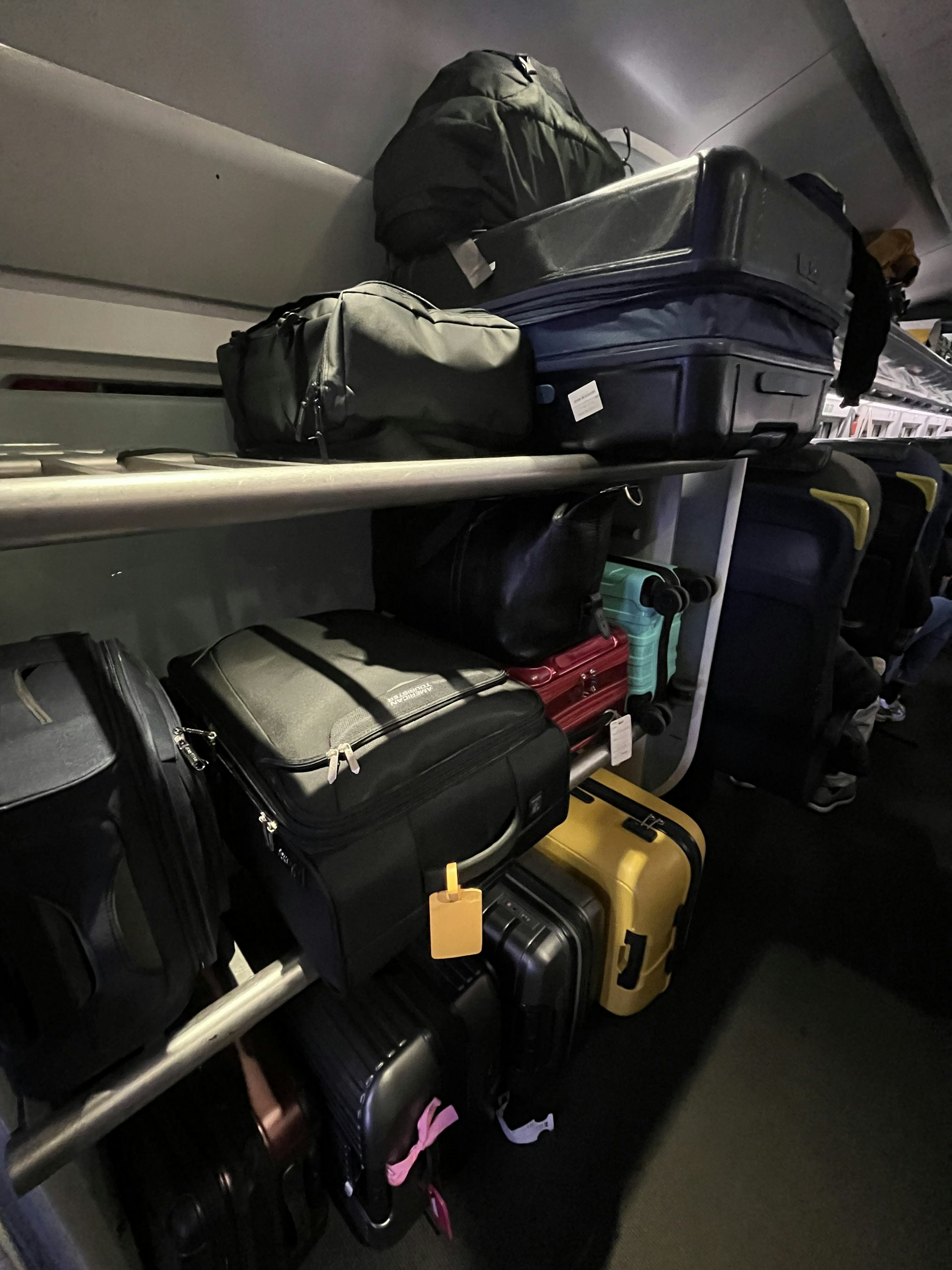
What can I take on the Eurostar?
You can take two bags up to 85cm/33.5in (at its widest/ longest point), plus one piece of hand luggage on the Eurostar. There’s no weight limit, but you do need to be able to lift your bags onto the train and potentially up to the rack above your seat.
There is luggage storage space at the end of carriages, but be aware that as we passed through Brussels on our way to Amsterdam, announcements were made to keep an eye on your belongings as thieves have been known to lighten the train’s load.
The best bit of traveling by train compared to flying: there are no restrictions on liquids. You can take all the products and bottled water you like (note that there is nowhere to refill on board). And if you’re up for a tipple, you can take one bottle of wine or bubbly or four cans of beer on board – except for during some major events, but you’ll get notified if that’s the case.
What else should I bring on the Eurostar?
There are UK and European plug sockets to recharge phones and laptops, although there are no USB sockets with Standard class seats. BYO book or download content to your devices in advance as the wi-fi and phone signal drops out regularly.
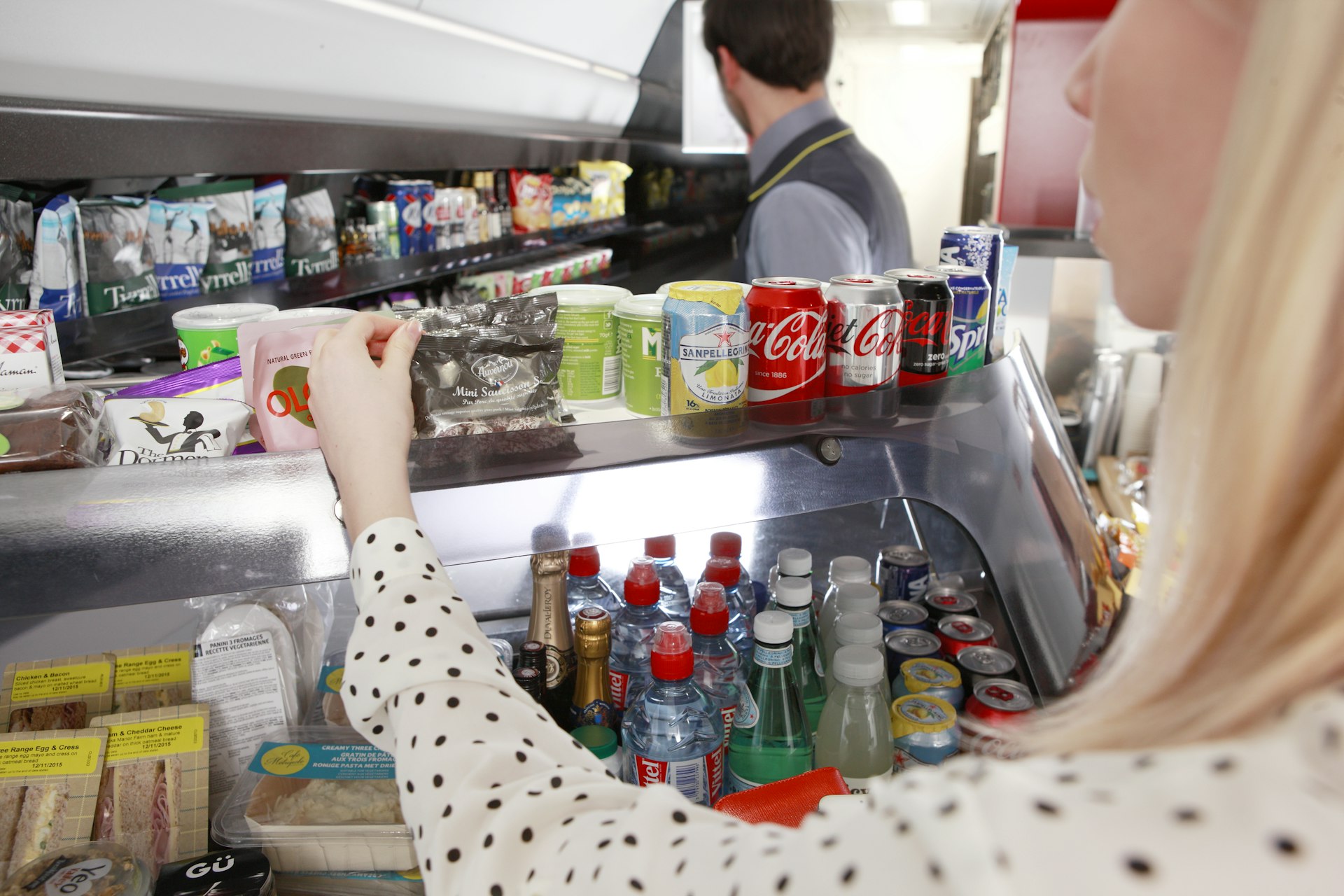
Can I buy food onboard the Eurostar?
There is a cafe carriage selling snacks and light meals for Standard class travelers (Premium classes get a meal delivered to their seats like on a plane). The menu changes twice a year, but the options are limited, so it’s often better to bring your own food, especially if you have dietary restrictions.
Buy your train supplies before you pass through passport control as the options inside the terminal at St Pancras were very busy the morning we traveled, while at Paris and Amsterdam they’re virtually non-existent.
What can’t I take with me on the Eurostar?
There’s a list of things you cannot take on the Eurostar on the website , most of which follow common sense: firearms, flammables, illegal drugs…. Perishable items like meat, fish and dairy are also on the list, but I am sure I could smell some scrumptious Dutch cheese in somebody’s bag on our way home!
Sadly taking a bike with you is a lot harder than one would hope, given the increase in interest in cycling to get around and cycling holidays in Europe. For full-sized bikes, you need to pre-book passage and disassemble your bike to check it in as luggage. Folding bikes and children’s bikes can be brought on board with you, but they need to be in a protective bag.
Do I need to print my Eurostar tickets?
Print your ticket out if you want a paper back up, but you can scan tickets directly from the Eurostar app at arrival gates. If your seat has changed for whatever reason, a fresh paper ticket will be printed for you at the gate.
Next, you move onto border control via security, like you do at an international airport.
Do I need a visa as well as my passport?
Make sure you are up-to-date on what documents you need for European travel, which varies by nationality.
As well as your passport, from late 2024 biometric information (a face scan or fingerprints) will be collected at European borders, which is expected to slow down the check-in process and may have a knock-on effect on the number of passengers that can be booked and processed per train.
Also note that from 2025, all non-EU citizens (that includes the British, obviously) will need an ETIAS (European Travel Information and Authorisation System) – a €7 visa-waiver scheme like the US ESTA – to enter Europe.
Wondering about your visa situation? We have guidance for France , the UK and Belgium
Do you really need to get there 90 minutes before your Eurostar train departs?
Yes, you really do. Cutting it fine can work out, but there are sometimes multiple trains from St Pancras, so queues can build quickly. Also seating inside terminals is limited, so do yourself a favor and get there on time.
What happens if I miss my train?
This has happened to me (or should I say, yes, I did this to myself), and Eurostar kindly rebooked our group on the next service headed to Paris. However we did lose our seat bookings and found ourselves in the backward-facing seats with no window views on the later train. Luckily the cafe carriage has large windows, so we congregated there for most of the journey.

How do you choose seats?
You’ll be allocated seats with your booking, but you can change these online or via the app. I recommend you do that as soon as you can because (as mentioned) there are seats on the Eurostar with no or partial views, and while 30 minutes is under the Channel, the rest of the journey is a chance to see the changing landscape.
Some Eurostar travelers also recommend bringing some kitchen towels or wet wipes and giving your window a clean – inside and out if you can – to improve the view.
Are there sleeper trains from London?
You’ve probably seen the headlines about Europe’s new golden age of train travel with more passengers embracing the greener alternative to short-haul flights. In 2024 there has been an uptick in sleeper train services in Europe, with new overnight routes from Paris to Berlin and Vienna to Hamburg on ÖBB's Nightjet.
There’s talk of the European Sleeper company connecting London to its night services via the Eurostar, so watch this space. And a sleeper train direct from London to further European cities may well be on the horizon.
Despite the challenges Brexit has put in its path, Eurostar maintains its ambitions to reach 30 million passengers by 2030. Given the London-to-Paris train journey emits 10 times less carbon per passenger compared to flying (22kg of CO2 per person versus 224kg of CO2), it really does make sense to get to and from Europe by rail.
Planning your first journey on a sleeper train? Here are our top tips
Explore related stories

Sustainable Travel
Jan 2, 2024 • 11 min read
From cutting through the countryside to connecting cities, these 24 railway journeys offer entirely new perspectives on a destination.

Nov 1, 2023 • 4 min read

Oct 19, 2023 • 8 min read

Jun 16, 2023 • 5 min read

May 19, 2023 • 12 min read

Dec 9, 2022 • 9 min read

Apr 28, 2022 • 2 min read

Oct 21, 2021 • 2 min read

Sep 20, 2021 • 5 min read

Sep 15, 2021 • 8 min read
From August 1 Onward: Required Documents for Bringing a Dog into the United States
The documents on this website are specific to the importation of dogs under CDC’s updated dog and cat regulation, effective August 1, 2024. All suspension rules remain in effect through July 31, 2024. If your dog is entering the United States before August 1, 2024, you must follow the rules of the temporary suspension. Please find relevant information (and use the DogBot) at What Your Dog Needs to Enter the United States . On August 1, the new requirements become effective.
The documents required depend upon where your dog has been vaccinated for rabies, and what countries they have been in during the six months before traveling to the United States.
Required documents for dogs with a current rabies vaccination administered in the United States that have been in a high-risk country for dog rabies within the 6 months before entry:
- The CDC Dog Import Form will be accessible beginning July 15, 2024. Check back at that time for travel occurring on or after August 1, 2024.
- The Certification of U.S.-issued Rabies Vaccination form must be completed by a U.S.-accredited veterinarian before the dog leaves the United States. U.S.-accredited veterinarians can access the form and its instructions at Veterinary Export Health Certification System (VEHCS) Help Page
- Instructions for veterinarians are available here: Instructions to complete the Certification of U.S.-issued Rabies Vaccination Form [PDF – 4 pages] .
- This document can be shown instead of the Certification of U.S.-issued Rabies Vaccination form.
- The rabies vaccination must be valid (not expired) on the date of return or the form will be invalid.
Required documents for dogs that departed the United States and have been only in dog rabies-free or low-risk countries during the 6 months before entry:
AND one of the following:
- The Certification of U.S.-issued Rabies Vaccination form must be completed by a U.S.-accredited veterinarian before the dog leaves the Unites States. U.S.-accredited veterinarians can access the form and its instructions at Veterinary Export Health Certification System (VEHCS) Help Page
- Lists the destination as the dog rabies-free or low-risk country from which the dog is returning (the form will only be valid for 30 days if it does not contain rabies vaccination information) (the form will only be valid for 30 days if it does not contain rabies vaccination information), or
- Documents a valid (unexpired) rabies vaccination administered in the United States (the form will be valid for the duration of the rabies vaccination (1 or 3 years)).
Required forms for dogs that have been in a country at high-risk for dog rabies within the 6 months before entry (and do not have Certification of U.S.-Issued Rabies Vaccination form)
- Certification of Foreign Rabies Vaccination and Microchip form [PDF – 2 pages] Fillable Adobe PDF forms don’t function properly within web browsers (Microsoft Edge, Google Chrome, etc). You should download fillable PDFs and complete them using Adobe Reader or Adobe Acrobat.
- Instructions to complete the Certification of Foreign Rabies Vaccination and Microchip form [PDF – 2 pages]
- For information on CDC-registered animal facilities, see: CDC-registered animal care facilities .
Optional, in addition to above forms, to avoid 28-day quarantine at a CDC-registered animal care facility:
- For information on CDC-approved laboratories, see: Approved Rabies Serology Laboratories for Testing Dogs .
Required documents for dogs that have been ONLY in countries that are dog rabies-free or low-risk during the 6 months before entry (and do not have Certification of U.S.-Issued Rabies Vaccination form or USDA-endorsed export health certificate)
- Certification of Dog Arriving from DMRVV-free or Low-Risk Country into the United States form
- Certification of Dog Arriving from DMRVV-free or Low-Risk Country into the United States form [PDF – 2 pages] Fillable Adobe PDF forms don’t function properly within web browsers (Microsoft Edge, Google Chrome, etc). You should download fillable PDFs and complete them using Adobe Reader or Adobe Acrobat.
- Instructions to complete the Certification of Dog Arriving from DRMVV-free or Low-Risk Country into the United States form [PDF – 2 pages]
- Veterinary records (including microchip number) for the previous 6 months
- Certification of Foreign Rabies Vaccination and Microchip form
- Valid rabies serology titer OR veterinary records (including microchip number) for the previous 6 months
- Contact your local veterinarian in the country of export for assistance obtaining this form.
- Travelers' Health
- Healthy Pets Healthy People
- Southern Border Health and Migration
- Port Health
- Division of Global Migration Health
To receive email updates about this page, enter your email address:
Exit Notification / Disclaimer Policy
- The Centers for Disease Control and Prevention (CDC) cannot attest to the accuracy of a non-federal website.
- Linking to a non-federal website does not constitute an endorsement by CDC or any of its employees of the sponsors or the information and products presented on the website.
- You will be subject to the destination website's privacy policy when you follow the link.
- CDC is not responsible for Section 508 compliance (accessibility) on other federal or private website.
‘We’re here to stay’: Why drag is critical in the US and sometimes safer abroad
To say that eight drag queens standing in front of the White House in full glam on May 6 was a momentous occasion for LGBTQ+ rights is an understatement given the climate for queer representation in 2024.
Of the 25 anti-drag performance bills proposed across the states, 14 were defeated, eight were introduced and two are advancing this year, according to the American Civil Liberties Union .
Two states, Tennessee and Montana, have already banned drag performances .
“Drag is like being a superhero. You know what I mean? We're changing lives,” Jorgeous, who is raising funds for the National Alliance of Mental Illness this season, told USA TODAY. “I know without drag, I probably wouldn't be here today, literally. Drag saved my life and it could do the same thing for others.”
The cast of RuPaul’s Drag Race All Stars 9 – Angeria Paris VanMicheals, Gottmik, Jorgeous, Nina West, Plastique Tiara, Roxxxy Andrews, Shannel and Vanessa Vanjie – stopped in Washington, D.C., for a premiere screening of the season’s first episode and a conversation with White House Press Secretary Karine Jean-Pierre.
Learn more: Best travel insurance
“Pay attention,” Jean-Pierre told the group at The Little Gay Pub in Washington. “Pay attention to what’s going on because our freedoms will be taken away.” This season’s theme of “queens save the world,” aims to showcase the power of drag with the queens competing on behalf of their chosen charity.
'You guys are not afraid of this?': Why some travelers are skipping the US
Shows like “RuPaul’s Drag Race,” “Dragula” and “We’re Here” have shone a light on the world of drag in the U.S. But increased attention can beget hate and sometimes it’s safer to be a drag queen abroad than at home.
“When I did a tour a couple of years ago, Christmas tour, at every stop we made there were bomb threats, Proud Boys were showing up at every single stop and it made me just kind of go like I can't believe this is where I live. I can’t believe this is my country,” Nina West, who is raising funds for The Trevor Project , said.
Is it safer to be a drag queen and perform abroad than in the US?
Traveling for work looks different when there are congressional efforts to ban your art form and profession. The vitriol espoused against drag queens by politicians, extremist groups and extremist right-wing media have real-life consequences for performers.
For Shannel, who’s been doing drag for 29 years and raising funds for the Anxiety and Depression Association of America , safety and staffing now play a part in the bookings she accepts.
A fellow performer recounted to her the verbal abuse he received during a Tennessee booking where protesters verbally assaulted Shannel's friend to the point that "he said he was not doing this again, and had I had, you know, more people behind me keeping me safe, it would have been a different situation.”
Vanessa Vanjie, who is raising funds for the ASPCA , mentioned things didn’t quite feel right in Tennessee either when rideshare requests were consistently canceled and she “started to feel like, you know, for the first time like I'm not safe … and we can't leave that hotel without people looking at us crazy.”
It becomes even more daunting when not only what you do is criminalized but who you are is also persecuted.
“We're super lucky to be able to live in a country where we're like fighting every single day for our rights and to be who we are. But at the same time, strong community that's ready to fight and stand up for who we are every day. And no matter who's in office, no matter what happens, we are not going anywhere, and we're gonna continue to be us. But worldwide it's crazy,” said Gottmik, the first out transgender man to compete on Drag Race.
A report by IGLA World found there are 13 countries with laws where trans people are essentially criminalized . Furthermore, 64 countries have laws that criminalize homosexuality .
“As a trans person, I can't even go to some of the places in the world that some of my friends will go because it's literally illegal for me to get booked there – like I can't even go. My friends have gotten held at security for going there for being trans,” Gottmik, who is raising funds for Trans Lifeline , added. “It's really important for us, in America to stand up and fight legislation that's against drag Queens and gay people or, you know, like literally anyone that's just trying to be themselves.”
Even so, some places might even offer a haven from American anti-drag sentiment.
“I feel like a lot of times when I go places, a lot of places kind of feel a lot safer, honestly, than even the U.S. I remember going to Australia and New Zealand and it was so safe there,” Angeria Paris Vanmichael, who is raising funds for National Black Justice Coalition , said.
Roxxxy Andrews, who is raising funds for Miracle of Love , explained that it often takes work on the backend from their management teams to ensure their safety and wellbeing. “We're usually very well taken care of where we're going and you know there's precautions and stuff like that, so people wouldn't put us in danger,” she said.
Whether it’s abroad or at home, the queens expressed a sense of duty to meet the moment when it comes to LGBTQ rights. Gathered around Jean-Pierre, the cast wanted to know how they could effectively use their platforms to fight against political attacks on their community.
“There's a responsibility specifically right now,” Nina West said of the importance of traveling and supporting the local drag shows. “Think about the girls who have the shows (in places like Tennessee) … I think it's really important that girls like us get to show up and support them.”
Making a difference through civic action
This season, the contestants will compete for a prize of $200,000 for their chose charity, in addition to $10,000 for each week’s challenge winner. The grand prize will be provided by The Palette Fund, a private foundation dedicated to advancing change in under-resourced.
During the season premiere screening in Washington, the cast opened up about each of their charities – some of which had representatives from the organizations in the audience – explaining the importance of supporting their work in order to have a strong and civically engaged LGBTQ community.
“I believe that drag queens and trans people have been in the front lines for many protests throughout the years for the LGBTQIA+ community, so I think that's why, they think that if they take drag things down, then the rest of the kingdom community will fall, too. And that’s not the case. We're here to stay and we're here to inspire,” Plastique Tiara, who is raising funds for The Asian American Foundation , said.
Season 9 of "All Stars" will begin on May 17 on Paramount+ with a two-episode season premiere.

IMAGES
VIDEO
COMMENTS
Alcoholic beverages with more than 24% but not more than 70% alcohol are limited in checked bags to 5 liters (1.3 gallons) per passenger and must be in unopened retail packaging. Alcoholic beverages with 24% alcohol or less are not subject to limitations in checked bags. Mini bottles of alcohol in carry-on must be able to comfortably fit into a ...
Prohibited and Restricted Items. CBP has been entrusted with enforcing hundreds of laws for 40 other government agencies, such as the U.S. Fish and Wildlife Service, the U.S. Department of Agriculture and the Centers for Disease Control and Prevention. These agencies require that unsafe items are not allowed to enter the United States.
If you violate foreign customs rules, you may be detained at the airport and fined. You may also have your items confiscated, and, in some cases, you may be prosecuted and/or sentenced to prison. U.S. Customs Restrictions - What You Cannot Bring Into the United States. You cannot bring some items into the United States.
Remove the 3-1-1 liquids bag and place it in the bin. Ensure pockets are empty (keys, tissues, currency, wallets, cell phones, etc.) and remove bulky jewelry (valuable items can be placed in carry-on). Remove your shoes and place them directly on the X-ray belt. Remove personal electronic devices larger than a cell phone from your carry-on bag ...
The 9 Essentials That Should Always Be On Your International Travel Packing List. Identification documents: passport, ID card, driver's license, documents for your children, etc. Country-specific documents: visa, vaccination certificate, health forms. Travel documents: boarding pass, booking confirmations, travel insurance. Cash: local currency.
Learn What I Can Bring on the Plane. Learn what you can bring on the plane by reviewing the Transportation Security Administration's (TSA) list of what you can bring on the plane, what you cannot bring on the plane, and TSA's Liquids 3-1-1 rule. Please note that the final decision rests with the TSA officer on whether an item is allowed through ...
Use this checklist to prepare for your next trip abroad. Make sure to bring items with you, since quality of items bought overseas cannot be guaranteed. Not all of these items may be relevant to you and your travel plans. Pack for a Healthy Trip. Prescription medicines . Your prescriptions; Travelers' diarrhea antibiotic; Medicines to prevent ...
1. A Travel Packing List For Your Carry-On . Packing your carry-on can make or break your international flight experience. If you don't have things to do, things to keep you comfortable, and things you absolutely need, then your flight will be less than enjoyable. On the other hand, if you plan ahead and consider what will help you feel most at ease, you're bound to have an amazing long ...
5/5. Quality. 5/5. Value. 5/5. Packing the right amount of clothing for an international trip can be a bit of a daunting task which is why we're such major advocates for the Gonex Compression ...
Other Information for U.S. Citizen Travelers. Information for Travel Agents. Travel to High-Risk Areas. Traveling with firearms. Traveling with a pet. Travel during tropical storm season. FBI Safety and Security Information for U.S. Students Traveling Abroad. Customs and import restrictions. Global Entry.
Buyers of both say that these packs have all the essentials you'll need to enjoy your trip such as tooth paste, a tooth brush, deodorant and a comb. $10 from Amazon $6 from Amazon. A refillable ...
If you're flying internationally, you may need to go through a second security screening before your flight: immigration. All you'll need to do here is show your passport and follow the instructions from the immigration staff. This is the last step before you can walk to your gate for your flight. 5. Find your gate.
3. Fly Delta APP. Download the Fly Delta app for a touchless travel experience. Access your boarding pass and check the seat map for blocked seats ahead of time from your own device. 4. Pre-Trip Email. Review your pre-trip email from us for information on how you can prepare for your upcoming trip. 5.
International Travel Documents. 1. Before packing your passport, make sure that the expiry date is longer than six months. Some countries won't let you in if the expiry date is too short. For your specific destination, read their laws for traveler's passport requirements. 2. Be sure to pack a traveling visa if needed.
Packing for international travel is an art form and sometimes can be one of the most daunting tasks when it comes to traveling abroad. Packing the right things helps to ensure your trip overseas ...
Put any liquids or gels you're traveling with in this bag, including shampoo, lotion, liquid makeup items and hand sanitizer. Keep in mind that all liquids and gels must be in travel-size bottles ...
Prohibited goods include: cannabis. food, plants, animals and related products that pose a risk to Canada. endangered species and anything made from the parts or endangered species (these can be found in some souvenirs) You may need a permit or written authorization to bring other goods into Canada, including.
Use the search box or view the complete list (alphabetical) to determine if an item can be packed in your carry-on or if it has to be placed in your checked baggage.. For items not listed here, simply send a picture or a question to CATSA on Facebook or Twitter (8 a.m. to 4 p.m. Eastern Time Monday-Friday). Please note. The final decision rests with the screening officer on whether an item is ...
You cannot take containers larger than 100 millilitres or 100 grams, even if they are partially filled. For example, a 200 gram toothpaste tube that is half-full is not allowed. At the screening point all liquids, aerosols and gels in your carry-on baggage must be separately presented for screening.
Wilkinson told me she had this advice for fellow fans going to the show abroad, "Enjoy the entire experience, from the moment you get on the plane until the morning after. You may be going for ...
That suspension will end when the new rules go into effect Aug. 1. "This will bring us up to speed with the rest of the international community which already has measures in place to prevent the ...
Travel Checklist for dogs that have been ONLY in countries that are dog rabies-free or low-risk in the 6 months before entry; 60-90 days before travel: Verify dog will be at least 6 months old on day of travel. Get dog microchipped or have a veterinarian verify its microchip number. Make sure the microchip number is listed on all veterinary ...
In 2024 there has been an uptick in sleeper train services in Europe, with new overnight routes from Paris to Berlin and Vienna to Hamburg on ÖBB's Nightjet. There's talk of the European Sleeper company connecting London to its night services, via the Eurostar, so watch this space. And a sleeper train direct from London to further European ...
This document can be shown instead of the Certification of U.S.-issued Rabies Vaccination form. The rabies vaccination must be valid (not expired) on the date of return or the form will be invalid. Required documents for dogs that departed the United States and have been only in dog rabies-free or low-risk countries during the 6 months before ...
Starting August 1, the tightened rules require that all dogs entering the US appear healthy upon arrival, be at least 6 months old, be microchipped and be accompanied by a "CDC Dog Import Form ...
Whether it's abroad or at home, the queens expressed a sense of duty to meet the moment when it comes to LGBTQ rights. Gathered around Jean-Pierre, the cast wanted to know how they could ...
In a bid to win the artificial intelligence race, Apple is reportedly bringing the biggest software update to its new iOS 18 set with generative AI technologies, Indian Express reported.During the...